
Top 50 Geography Research Topics [Revised]
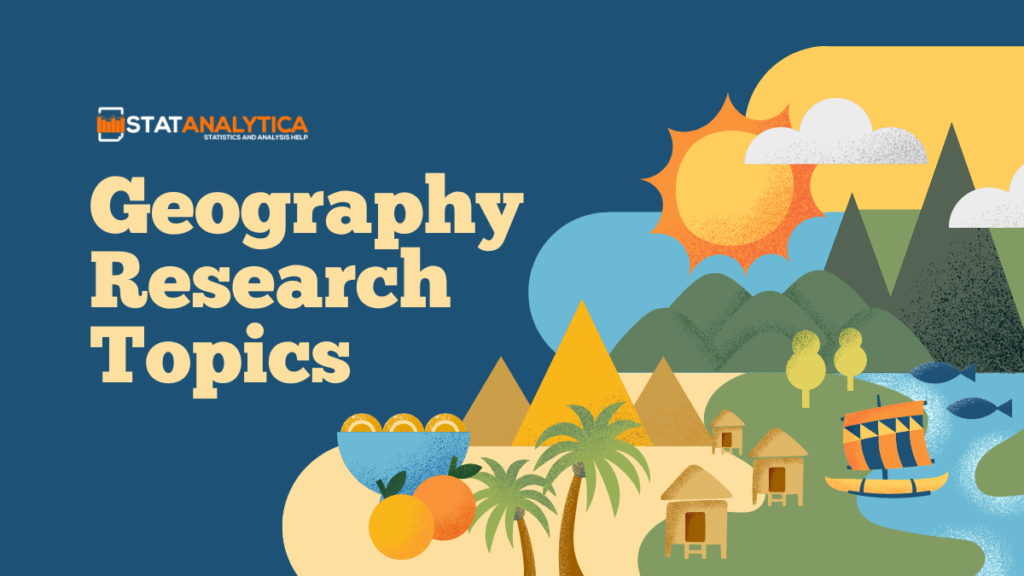
Geography isn’t just about maps and memorizing capital cities; it’s a dynamic field that delves into everything from understanding our planet’s physical features to unraveling the complexities of human societies. In this blog, we’ll embark on a journey through fascinating geography research topics, ranging from climate change and urbanization to cultural dynamics and emerging trends. Whether you’re a curious student or simply someone intrigued by the world around you, join us as we explore the diverse realms of geography research.
What Are The Three Main Topics Of Geography?
Table of Contents
- Physical Geography
- Study of Earth’s physical features, processes, and phenomena.
- Example: Investigating the formation of mountains, erosion patterns in river systems, or the impact of climate change on ecosystems.
- Human Geography
- Examination of the interactions between human societies and their environments.
- Example: Analyzing urbanization trends, migration patterns, cultural landscapes, or economic activities within specific regions.
- Environmental Geography
- Focus on the relationship between humans and their natural surroundings, including the impact of human activities on the environment.
- Example: Researching pollution levels in urban areas, deforestation rates in tropical rainforests, or the conservation of endangered species and habitats.
50 Geography Research Topics: Category Wise
Physical geography research topics.
- Impact of climate change on polar ice caps.
- Patterns of desertification in arid regions.
- Formation and evolution of volcanic islands.
- Study of river meandering and channel migration.
- Factors influencing the distribution of biomes worldwide.
Human Geography Research Topics
- Urbanization dynamics in developing countries.
- Social and economic impacts of gentrification in urban neighborhoods.
- Migration patterns and trends in Europe.
- Cultural landscapes and identity politics in contested territories.
- Gender disparities in access to resources and opportunities in rural areas.
Environmental Geography Research Topics
- Analysis of air quality in megacities.
- Impacts of deforestation on local biodiversity in the Amazon rainforest.
- Water scarcity and management strategies in arid regions.
- Ecotourism and its role in sustainable development.
- Effects of marine pollution on coral reef ecosystems.
Geographical Techniques and Tools Research Topics
- Applications of Geographic Information Systems (GIS) in disaster management.
- Remote sensing techniques for monitoring agricultural productivity.
- Cartographic visualization of population density and distribution.
- Spatial analysis of crime patterns in urban areas.
- Geographical modeling of disease spread and containment strategies.
Regional Geography Research Topics
- Socioeconomic disparities between urban and rural regions in India.
- Geopolitical tensions in the South China Sea.
- Cultural diversity and integration in multicultural cities like London or New York.
- Environmental challenges facing the African Sahel region.
- Regional impacts of globalization on indigenous communities in South America.
Cultural Geography Research Topics
- Influence of religion on cultural landscapes in the Middle East.
- Cultural diffusion and globalization in the digital age.
- Preservation of intangible cultural heritage in UNESCO World Heritage sites.
- Impact of colonialism on indigenous cultures in Australia.
- Gender roles and cultural practices in traditional societies.
Economic Geography Research Topics
- Spatial distribution of industries in emerging economies.
- Trade patterns and economic integration in the European Union.
- Impact of globalization on labor markets in Southeast Asia.
- Role of transportation infrastructure in regional economic development.
- Economic consequences of natural disasters on local communities.
Political Geography Research Topics
- Border disputes and territorial conflicts in the Middle East.
- Secessionist movements and autonomy struggles in Europe.
- Role of international organizations in conflict resolution and peacebuilding.
- Geopolitical implications of Arctic resource extraction.
- Influence of soft power and cultural diplomacy in international relations.
Social Geography Research Topics
- Spatial patterns of poverty and social exclusion in urban areas.
- Dynamics of neighborhood segregation and integration in diverse cities.
- Impact of social media on community engagement and activism.
- Gender-based violence and spatial justice in urban environments.
- Cultural dimensions of health disparities in rural communities.
Historical Geography Research Topics
- Legacy of colonialism in shaping urban landscapes in former colonies.
- Evolution of trade routes and their impact on cultural diffusion.
- Archaeological landscape studies of ancient civilizations.
- Historical geography of migration and diaspora communities.
- Environmental history of industrialization and its long-term impacts on ecosystems.
How To Write A Geography Research Paper?
Writing a geography research paper involves several key steps to ensure a well-structured, coherent, and informative document. Here’s a step-by-step guide on how to write a geography research paper:
- Choose a Topic: Select a specific and focused research topic within the field of geography that interests you. Consider the scope of your paper, available resources, and the significance of the topic in the field.
- Conduct Research: Gather relevant sources of information such as scholarly articles, books, journals, government publications, and online databases. Use both primary and secondary sources to support your research and develop a comprehensive understanding of the topic.
- Develop a clear and short thesis statement that explains what your research paper is about. This statement should show the main idea or point you’re going to talk about in your paper.
- Organize your paper by making a plan or outline. Split it into different parts like the introduction, where you start talking about your topic and explain why it’s important. Then, include a literature review where you talk about what others have already studied about your topic. If you did any special methods in your research, talk about them in the methodology section. Then, show your findings or results, discuss them, and finally, conclude your paper. Make sure you outline all the important things you want to talk about in each section.
- Start your paper with an interesting introduction. Tell the reader some background information about your topic and why it’s important. Also, introduce your thesis statement here. Explain what you’ll be talking about in your research paper to help guide the reader through your paper.
- Conduct a Literature Review: Review existing literature and research related to your topic to contextualize your study and identify gaps or areas for further investigation. Summarize key findings, methodologies, and theories from previous studies to support your own research.
- Describe Your Methodology (If Applicable): If your research involves empirical data collection or analysis, describe the methodology and research design used in your study. Explain the research methods, data sources, sampling techniques, and analytical tools employed to gather and analyze data.
- Present Your Findings: Present the results of your research in a clear and systematic manner. Use tables, graphs, maps, and other visual aids to illustrate your findings and enhance comprehension. Provide descriptive and analytical interpretations of the data to support your arguments.
- Discuss Your Results: Analyze and interpret the significance of your research findings in relation to your thesis statement and research objectives. Discuss any patterns, trends, or relationships observed in the data and explore their implications for the broader field of geography.
- Draw Conclusions: Summarize the main findings of your research and reiterate the significance of your study. Discuss any limitations or constraints encountered during the research process and propose areas for future research or further investigation.
- Cite Your Sources: Ensure that you properly cite all sources of information used in your research paper according to the citation style specified by your instructor or academic institution. Use in-text citations and include a comprehensive bibliography or reference list at the end of your paper.
- Proofread and Revise: Review your research paper carefully for grammatical errors, typos, and inconsistencies. Revise and refine your writing to improve clarity, coherence, and overall quality. Consider seeking feedback from peers, mentors, or academic advisors to further enhance your paper.
Emerging Topics in Geography Research
As our world continues to evolve, new frontiers of geography research are constantly emerging. From the quest for sustainable development to the rise of smart cities and the challenges of climate resilience, researchers are grappling with complex issues that defy easy solutions.
One promising avenue of research is the integration of indigenous knowledge and perspectives into geographic studies. By recognizing the wisdom of traditional cultures and their deep connection to the land, researchers can develop more holistic approaches to environmental management and conservation.
In conclusion, geography research offers a rich tapestry of topics that span the natural and social sciences. Whether it’s unraveling the mysteries of climate change, exploring the dynamics of urbanization, or celebrating the diversity of cultural landscapes, there’s something for everyone in the world of geography research.
So, whether you’re a student embarking on geography research topics or simply a curious explorer seeking to understand the world around you, take heart in knowing that the adventure has only just begun. Happy exploring!
Related Posts

Step by Step Guide on The Best Way to Finance Car

The Best Way on How to Get Fund For Business to Grow it Efficiently
Leave a comment cancel reply.
Your email address will not be published. Required fields are marked *
Questions? Call us:
Email:
- How it works
- Testimonials
Essay Writing
- Essay service
- Essay writers
- College essay service
- Write my essay
- Pay for essay
- Essay topics
Term Paper Writing
- Term paper service
- Buy term papers
- Term paper help
- Term paper writers
- College term papers
- Write my term paper
- Pay for term paper
- Term paper topic
Research Paper Writing
- Research paper service
- Buy research paper
- Research paper help
- Research paper writers
- College research papers
- Write my research paper
- Pay for research paper
- Research paper topics
Dissertation Writing
- Dissertation service
- Buy dissertation
- Dissertation help
- Dissertation writers
- College thesis
- Write my dissertation
- Pay for dissertation
- Dissertation topics
Other Services
- Custom writing services
- Speech writing service
- Movie review writing
- Editing service
- Assignment writing
- Article writing service
- Book report writing
- Book review writing
Popular request:
Top 100 geography topics for research.
April 13, 2021
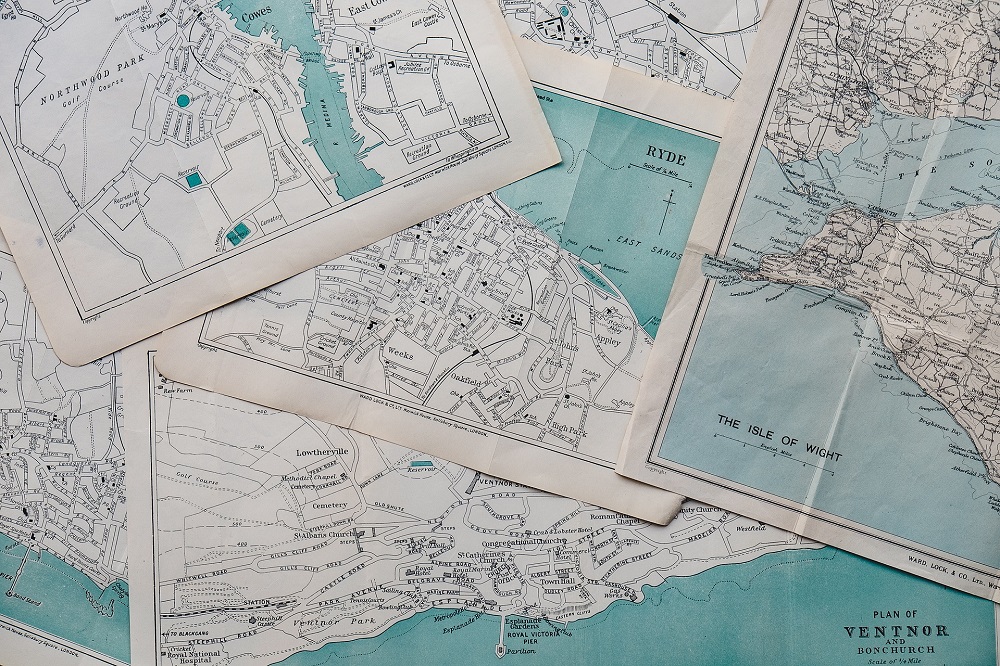
Your geography paper or essay can also cover multiple fields. You can also opt to write on scientific or empirical geographic models. Alternatively, you can write about how humans relate to the environment. If your educator has asked you to write a research paper or essay, here are some of the best geographical topics to consider for your project.
Unique Geography Topics
Maybe you like researching and writing about unique ideas. And this is very important because uniqueness is one of the factors that educators consider when grading academic papers and essays. Here is a list of unique geography topics for research that you should consider.
- Environmental and social-economic effects of gas and oil exploration in your town
- Demographic and land-use changes in your area
- Cartography history
- The emerging grassland agriculture trends
- Badland areas geomorphological changes
- How human activities contribute to climate change
- What causes soil erosion – How to mitigate it
- How weather variables like wind, temperature, and snow contribute to the vegetation in native grassland
- Effects of wet summer on agricultural production
- Effects of modern farming techniques on agricultural production
- Science historical geographies
- How to control galley erosion in your area
- How volcanic action affects land fertility
- Mapping for landslide hazard and potential solutions
- How acidification of ocean weather affects the marine life
- How weather patents relate and possible mitigation in various countries
- Effects of high urban areas’ population
- How global warming affects the planet
- How to manage the aging infrastructure
- How to deal with urbanization and expansion in big cities
These are some of the best world geography project ideas to explore when writing an essay or a paper. Nevertheless, take your time to research your topic extensively and analyze data to come up with a solid paper.
Cultural Geography Topics
Cultural geography is among the major science branches, alongside social, political, and economic geography. It entails the study of ethnic geography. And this covers religion, art, and languages. Maybe you love researching and writing about cultural geography. In that case, consider these cultural geography essay topics.
- The educational systems in western and eastern cultures
- Geographical aspects of the world religions’ study
- The role women play in the Chinese society
- Heritage monuments in the geo-cultural space
- The Native culture’s influence on human psychology
- How globalization benefits developed and developing countries
- How cultural superiority affects how humans behave
- How globalization has affected the Chinese economy
- The role of cultural geography in promoting tourism
- The most represented food in my country
These are brilliant cultural geography research paper topics. Pick any of these ideas and then develop them to suit your project.
Human Geography Topics
Human geography entails the study of the network and distribution of people and different cultures across the world. It’s also about the study of how humans relate to their physical environment. Here are some of the best human geography research topics to consider for your papers.
- India and China – The universal effects of the increasing economic powers of these countries
- Ethnic Dressing evolution through different centuries
- Human culture – How it has changed over time
- The untoward impacts of overgrazing on the Mongolian Steppe’s agricultural production
- World Power – The evolution of China into a powerful country
- The development of military geography
- The expansion of large cities – how does it affect the environment?
- Settlement movements of the Scythians
- How the Indian population growth impacts the environment
- The spread of the South African diseases
These are interesting human geography essay topics. But, you should research your ideas carefully and extensively to come up with a solid paper regardless of your chosen topic.
Physical Geography Research Topics
Physical geography is arguably a major field in this subject. It entails the study of the natural environment. This includes the patterns and processes like the atmosphere, biosphere, hydrosphere, and geosphere. Ideally, physical geography covers both the built and cultural environment. Here are some of the best physical geography topics to consider for your paper or essay.
- How climate change affects the intensity of the Australian bushfire
- The meteorology history and its effects on modern research
- River ice – The worldwide effects of the high ice loss rate across the globe
- How the Australian bush fires affect the global weather
- Organizational forms of the living matter on earth
- The evolution and origin of the biosphere
- The geographical envelope and its causes
- Environmental nihilism and environmental determinism
- Forms of chemical elements migration
- The atmospheric vertical structure – Gas composition features of air and the determining factors
- Characteristics of the elementary geochemical landscapes
- The significance of the main gases in the atmosphere
- Alkalinity and acidity of the soil – How to regulate them
- The soil horizons color – How physicochemical properties of the constituent substances of the soil depend on their color
- Soil formation – The anthropogenic factors
- The role of endogenous geological processes in earth l formation
Physical geography is generally a complete sciences’ system that entails the study of dynamics, structures, and functioning of the geological envelope, as well as, its structural parts. Pick your geography topic from this category if you love exploring the environment in its natural and man-made forms.
Interesting Geography Topics
Do you want to research and write about something interesting? In that case, consider this category of interesting geography paper topics.
- Features and qualities of coastal erosion
- Why should humans protect the endangered rain forests tree species?
- Why glaciers melting is happening faster than predicted
- Which was the worst ecological crisis in the world’s history
- Meteorological science – Is it accurate or real?
- How to minimize the effects of deforestation
- Effects of floods on the lives of humans
- Hurricanes effects and how to predict them
- An exploration of geographical features of a desert
- Human roles in the increasing global warming
- Why earthquakes and landslides are popular today
- Can eco-friendly food feed the world?
- How to use innovative technologies to produce eco-friendly food
- The role of humans in their extinction
- How a volcanic eruption occurs
- How humans have contributed to the ever-changing climate
- How oil and gas exploration affects the social issues
- How volcanoes affect nearby settlements
- The happenings and process of earthquakes
- Factors that lead to the urbanization of some areas over time
- Indicators and causes of climate change
Choose your geography research topic from this category and then develop it extensively. Use reliable and authentic sources to find relevant information for your paper or essay to earn the top grade.
The Best Geography Research Topics to Choose from
Maybe you want to pick your geography essay topics from a list of the best ideas. Whether you need AP human geography topics or world geography topics, this list comprises the best ideas to consider when writing your paper or essay.
- The main causes and effects of earthquakes
- A description of the Amazon basin formation
- How flooding helps in sustaining life
- Environmental effects of oil exploration
- Common hazards associated with landslides
- Glaciers formation – Describe this process
- Dumping waste alternatives
- Explain the impact of the atomic blasts on Nagasaki and Hiroshima
- Continental drift process from Pangaea until today
- How geography relates to climate
- How water bodies affect the climate
- How public housing affects the housing industry
- Influence of geographical location on a country’s climate
- What causes water pollution?
- What causes the eruption of wildfire
- Effects of the rising industrialization trend
- What should humans do to protect rare species
- How to protect floods
- How to prevent human-animal conflicts
- How to deal with the continuing water crisis
- The severity of natural disasters in the modern world
- What’s the responsibility of individuals in curbing global warming?
- How using green energy can substitute fossil fuels
These are amazing topics to consider when writing an essay or a research paper. Take your time to understand each of these ideas to pick the one you will be comfortable working with.
Students have many ideas to explore when writing academic papers and essays. However, the most important thing is to choose a topic you will be happy to research and write about. What’s more, understand the requirements and instructions set by your educator when exploring different geographical project topics. Additionally, take your time to find relevant sources, gather and analyze information before writing. That way, you will come up with a paper that will impress the educator to award you the top grade. You can also contact our writing service to save your time and effort.

Take a break from writing.
Top academic experts are here for you.
- How To Write An Autobiography Guideline And Useful Advice
- 182 Best Classification Essay Topics To Learn And Write About
- How To Manage Stress In College: Top Practical Tips
- How To Write A Narrative Essay: Definition, Tips, And A Step-by-Step Guide
- How To Write Article Review Like Professional
- Great Problem Solution Essay Topics
- Creating Best Stanford Roommate Essay
- Costco Essay – Best Writing Guide
- How To Quote A Dialogue
- Wonderful Expository Essay Topics
- Research Paper Topics For 2020
- Interesting Persuasive Essay Topics
- Publications
One of the main activities of the Society is being focused on publication of research findings of geographers mainly. The first publication of the journal, titled as “The Calcutta Geographical Review” (renamed as The Geographical Review of India since 1951) made its maiden appearance in September 1936, being enriched with various information and several valuable papers of world standard. Publication of the Review, ever since its inception, has been the most important and a vital activity of the Society. By the time of Golden Jubilee of the Society in 1983 as many as 1,115 articles and notes, contributed by no less than 582 authors were brought out in the Society’s journal. By the time of Platinum Jubilee of the Society in 2008 more than 2,000 research papers have been brought out in the journal. All these articles published in the journal covered as many as 50 topics of geography. The Geographical Review of India is brought out quarterly in the months of March, June, September and December. The journal contains articles, notes, book reviews, news etc. for professional geographers and others.
At present, it is desired that the contributors to the journal follow the norm set-out in the sequel under the head, “Notes for Contributors to the Journal”.
Notes for Contributors to the Journal
The Journal, “Geographical Review of India” is peer reviewed and published quarterly (March, June, September and December) by the Geographical Society of India. It contains full length articles, short communication, book reviews etc. on all aspects of Geography deemed relevant to the professional geographers and researchers in allied fields. Following are the guidelines for submission of articles to the journal.
- The paper should be printed in Times New Roman font. 12 points in double space on one side of A4 size paper with margins of at least 1.5 inches and should not exceed 5000 words/12 pages, including original drawings, essential tables and cited references. The hard and soft copies of the paper should be sent to The Geographical Society of India. The CD will include one file in docx / doc format containing complete paper i.e. text with diagrams in their respective positions. The diagrams used in the paper also be submitted separately in jpeg / tiff files in that CD. A copy of the paper should also be sent to the following e-mail address [email protected] . A copy of the paper may be retained by the author for ready reference. The papers will not be returned to the authors in case of rejection or delay in publication. The copyright will belong to The Geographical Society of India.
- The paper should also contain (i) A short title, (ii) An abstract of the paper not exceeding 100 words along with at least five keywords and (iii) Author’s designation, e-mail address, mobile number.
- Relevant references should be given at the end of the paper arranged alphabetically by the author, followed by the year of publication within parentheses, name of the book/article/ journal, name of the publishers, the place of publication and relevant pages in succession conforming to the standard followed in the journal. Only those references which are used in the text should be included. Sample references are as under. Article in Journals: Agrawal, A. (1995): Dismantling the Divide between Indigenous and Scientific Knowledge, Development and Change , London, 26(3), pp. 413-439. Article in Edited Books: Teli. B.L. (1999): Water resources of the U.P. Himalaya: Potentials and Planning, in Rawat, M.S.S. et. al (eds.), Environmental Management and Regional Development in the Himalaya, Surya International Publication, Dehradun, p. 45. Article in Books: Choudhury, P.C. (1987): The History of Civilisation of the People of Assam in Twelfth Century A.D., Spectrum Publications, Guwahati, pp. 334-337. Unpublished Thesis : Basu, S.R. (1972): The Decay and Associated Problems of the River Dynamics of the Bhagirathi Valley, unpublished Ph.D. thesis, University of Calcutta, Kolkata, p. 206. Internet Resource: Mention DOI number (if applicable), full URL and date of retrieval as YYYY-MM-DD at the end of reference. For example – NOAA: National Ocean and Atmospheric Administration (2009), Sothern Oscillation Index (SOI) monthly data: 1866 to 2006, Earth System Research Laboratory, Physical Science Division. www.cdc.noaa.gov/gcos_wgsp/Timeseries/Data/soi.long.data (retrieved on 2010-10-21).
- Maps and diagrams should be of good quality suitable for reproduction on the page format (14 cm x 8 cm) of the journal and should be captioned. Essential colour maps and diagrams may be published, provided the cost is borne by the author(s).
- Measurement should be in the international system of units (SI).
- The oxford English diction, spelling should be followed.
- While submitting an article for publication in the Geographical Review of India, the author(s) should ensure that the concerned article has not been published and would not be submitted for publication elsewhere.
- All authors / co-authors should be members of the Geographical Society of India. They must continue their membership till the publication of the concerned article in the Geographical Review of India.
- The Honorary Editor is endowed with full right to edit and adjust articles in order to conform to the format of the journal.
- The Geographical Society of India or the Honorary Editor will not be held responsible for the views expressed by the author(s) in the published paper.
- The journal is distributed free of charge to the members of the Society.
- Papers not conforming to the above rules may not be considered for publication. Papers, geographical notes, book reviews etc. are accepted for publication with the approval of the Publication Committee of the Society.
Process of review of articles and their publication in the journal
Articles submitted by the contributors are sent to reviewers selected by the Publication Committee called other wise as Editorial Board. Hony. Editor acts as convener of the Editorial Board. On receiving the comments from the reviewer the article is sent back to the author for its revision, if needed. The two categories of articles – one okayed by the reviewer and the other revised by the author are scrutinized by the editor along with other members of the Editorial Board. The edited articles are sent to the press for final printing.
Editorial Board (Publication Committee) Members, 2018-19
Prof. Lakshmi Sivaramakrishnan is the Editor of the journal.
Name of the Editors of the journal since 1936
List of Reviewers, 2018-19
Some important features of the journal, “Geographical Review of India”
Published Bulletins and Monographs
The Society also brought out, time to time, almost from the very beginning, a number of occasional Bulletins and other research Monographs in addition to the regular Journal. Some of these valuable occasional publications are as under :
- Poland and its Frontiers, by S. P. Chatterjee, 1939, 28 pp.
- Turkey and Her Problems, by S. P. Chatterjee, 1940, 42 pp.
- Holy Places of India, by B. C. Law, 1940, 57 pp.
- Notes on Geological Maps and Sections, by N. L. Sharma, 16 pp with 6 plates.
- Mountains of India, by B. C. Law, 1944, 27 pp. with illustrations.
- Rivers of India by B. C. Law, 1944, 56 pp. with illustrations.
- All authors/co-authors should be members of the Geographical Society of India. They must continue their membership till the publication of the concerned article in the Geographical Review of India.
- Land Utilization in the District of 24-Parganas, by S. P. Chatterjee, 1947, 66 pp. with maps + xii photographic plates.
- Essays in Geography-S. P. Chatterjee Volume to Commemorate Completion of his 60th year, ed. by M. R. Chaudhury, 1964, xi + 219 pp.
- Geographical Review of India : Index Volume (1936 – 2011).
- Multi-Lingual Dictionary of Remote Sensing and Photogrammetry (English, French and Bengali), by G. B. Das,1991, v + 55 pp.
- Impact of Development on Environment, Symposium Papers, Volume I, ed. by B. Banerjee.
- Impact of Development on Environment, Symposium Papers, Volume II, ed. by P. K. Saha
- Calcutta : Land and People, ed. by P. K. Saha, 1993.
- Environment and Development, ed. by R. Bhattacharyya, 2001.
- The Partition of Bengal, by S. P. Chatterjee, 2nd edition, with a Foreword by S. P. Das Gupta, 2006, xx + 80 pp. with 19 maps and figures.
- Journal home
- About the journal
- J-STAGE home
- Journal of Geography (Chigaku ...
- Volume 121 (2012) Issue 5
- Article overview
Graduate School of Letters, Hiroshima University
Joint Graduate School in Science of School Education, Hyogo University of Teacher Education
Graduate School of Human Development and Environment, Kobe University
Professor of Geography (Retired), University of Madras
Corresponding author

2012 Volume 121 Issue 5 Pages 874-890
- Published: October 25, 2012 Received: October 12, 2011 Released on J-STAGE: December 05, 2012 Accepted: February 08, 2012 Advance online publication: - Revised: -
Correction information
(compatible with EndNote, Reference Manager, ProCite, RefWorks)
(compatible with BibDesk, LaTeX)
This paper examines the present status of geography in India and problems based on trends in modern history, geography education and research. Geography has developed remarkably in higher education since the country won independence from Great Britain. Large numbers of universities and colleges have been established since the 1960s, and departments of geography have also opened rapidly with a spatial bias towards the North India Region. In 1992, 66 university departments in the country taught geography and undertook research. Human geography receives more emphasis than physical geography. In the former, agricultural geography and urban geography were the most active fields of the research. Regional planning has also occupied the interests of geographers under the country’s planned economy. In recent years, the technologies using computers such as GIS and remote sensing have been introduced into the discipline, and have driven development in geography departments. However, various problems are pointed out in the present status of geography. There are questions about innovation in geographical theory, methodology and education.

- Add to favorites
- Additional info alert
- Citation alert
- Authentication alert
Register with J-STAGE for free!
Already have an account? Sign in here

Encyclopaedia of the History of Science, Technology, and Medicine in Non-Western Cultures pp 978–985 Cite as
Geography in India
- Ashok Dutt &
- Meera Chatterjee
- Reference work entry
159 Accesses
Download reference work entry PDF
The study of geography as a systematic science was a significant gap in Indian knowledge during ancient times. However, geographical facts were presented in a nonsystematic manner in the whole range of Sanskrit, Pali, and Prakrit literature. Compositions of a geographical character are often found embedded in the religious, legendary and astrological literature of ancient India. Both religious and secular literature contain numerous isolated references to cities, mountains, rivers, regions, and society, which collectively amount to a considerable addition to geographical knowledge. India is the home of an ancient civilization that originated over 5,000 years ago and attracted many travelers, scholars, ambassadors, and missionaries. Many conveyed impressions back to their compatriots through lively tales, anecdotes, and travel journals. These writings also became important sources of geographical knowledge. The writings of the Chinese, Greek, and Arab geographers are rich sources of information relating to various aspects of geographical science. Various names such as Bhuvankosa (Terrestrial Treasure), Trilokya Darpaṇa (World's Mirror) and Kṣetrasamāsa (Combination of Countries) were used to denote geographic phenomena. Hence, the principal sources of information about the status of geography in ancient India are sketchy because they are obtained from references extracted from nongeographical works, foreign accounts, and inscriptions. The ancient literature developed over the centuries could easily be arranged in a chronological sequence. Ṛg Veda (about 1500 BCE) was the first, which was followed by three other Vedas, Sama, Yajur, and Atharva . The Upaniṣads, Purāṇas, Jātaka tales and great epics – Rāmāyana and Mahābhārata were composed between 1000 and 500 BCE. Kautilaya's Arthaśāstra was composed around 300 BCE. Other than these, there are writings of different poets and foreign people that also help us to infer the geography of ancient India.
The Ṛg Veda is the earliest Indian literature that has been discovered. It mentions many geographical facts such as tribes, rivers, and mountains. According to Al‐Bīrūnī (Alberuni), an Arab traveler in India, “Veda is knowledge of that which was unknown” (Kazmi 1995 : 41). These and associated books contain knowledge about philosophy, mathematics, medicines, navigation, music, and dance. The Upaniṣads are works on religious meditation (Tamaskar 1985 ). It is difficult to find any direct description of the earth or the world, but, as in the Ṛg Veda , geographical phenomena or features are embodied in them. Like the Vedas , the Purāṇas also did not deal with geography in a systematic manner; however, they have a lot of geographical facts in them. The scientific material covers a wide range of topics from astronomy, cosmography, and cosmogony to the classical concept of region and regional classification. As defined by Alberuni, Purāṇa means “first eternal” and the Purāṇas are associated with the names of animal, human or angelic beings. Purāṇas not only contain mythical and legendary materials, but also contain scientific information, which is sometimes accurate. Information about astronomical geography can be easily extracted out of the Purāṇas . Jātaka tales are a huge source of unsystematic geographical information. The legendary stories contained in the Jātakas relate the previous lives of Gautama Buddha, the founder of Buddhism. He lived and preached in northeast India between 563 and 483 BCE. As there was no written common language, the stories were memorized and handed down from generation to generation by word of mouth. Several hundred years later they were written down in the Pali language; in the process many facts were exaggerated or lost. The Jātaka tales were set in some contemporary kingdoms. Kautilaya's Arthaśāstra mentions the names of a few mountains, regions, and tribes. It also provides us with a lot of information about territorial sovereignty and geopolitical principles. The great epics Rāmāyana and Mahābhārata contain extensive geographical descriptions of north and south India, military geography, family structure and the presence of non–Aryan tribes. ( Mahābhārata depicts the war that occurred about 900 BCE).
The Aryans, who brought the Ṛg Veda from outside the borders of India (possibly from Persia), first settled in northwestern India (Punjab and the Indus plain). They mentioned regional rivers and their branches, such as the Saraswati (extinct), Sutudri (Sutlej), and Sindhu (Indus) (Fig. 1 ). The rivers, seas and regions had different names in ancient India. A few of them are mentioned in Fig. 1 . According to Ṛg Veda, Saraswati was the greatest and most powerful river that flowed from the mountains to the sea. The greatest and the holiest river mentioned was not the Ganges, but the dry Saraswati. The latest studies have shown that the Ṛg Vedic Saraswati was a perennial river. The confluence of the Ganges (Gaṅgā) and its tributary Yamuna are mentioned as the eastern boundary of the Aryan settlement. However the Ganges was mentioned only once, whereas the Saraswati was mentioned many times.

Rivers, regions, and maritime features of South Asia. Base map from Dutt and Geib 1998 . Permission obtained from the copyright holders. The authors gathered the information on the names of the ancient rivers from various sources.
By the beginning of the Christian era, three other Vedas, epics and Purāṇas were written, and a more extensive description of Indian geography evolved. The Aryan settlements advanced eastward all the way to Bengal and toward southern India. The latter, though Dravidian in terms of linguistic and physiognomic characteristics, became Hinduized.
Ṛg Veda set the layout of an important aspect of social geography by stratifying Indian society into four different castes. (1) Brahmins , who were the interpreters of religious texts and handled all the scholarly literature, (2) Khasatriyas , the warriors and the rulers, (3) Vaiśyas , the merchants and farmers and (4) Śūdras, slaves who did all the hard work including cutting jungles to make land arable. Some of them were designated as untouchables. The following extract is based on Ṛg Veda explains the function‐based, social hierarchy (four castes).
The brahmans form the highest social order, the literate intelligentsia which gave India its priests, thinkers, law‐givers, judges, and ministers of state. The rajanyas , later called khsatriyas or rulers, were the second social order. The Indian counterpart of feudal nobility: from this class was recruited kings, vassals and warriors. The vaishyas formed the class of landowners, merchants, moneylenders, while the śūdras originally those people conquered by Aryans, were workers, artisans, or serfs. ( Ṛg Veda , 10.90, as cited in De Bary 1967 : 13–14.)
The caste system still persists among the Hindus. As most of the Muslims and Christians in India are converted from Hinduism, many of them have retained their caste distinction.
Ancient Indians also knew about the land and water ratio on the earth's surface. Though they did not have accurate knowledge of the ratio, they believed that oceans occupied twice as much area as the land surface on the Earth. In the second Anuwaka of third Brāhmana of III Adhyaya of the Bṛihadāranyaka‐Upaniṣad it is said, “The oceans surround this earth on every side twice as large” (Tamaskar 1985 : 7).
The Himalayas were mentioned in Upaniṣads as the “White Mountains” because their upper reaches are snow clad year‐round. The rivers flow out of this mountain chain in an east and west direction. They have also been referred to as a powerful barrier for invaders, thus acting as natural borders.
The river Ganges is mentioned in the Vayu‐Purāṇa as a purifier of sinners, passing through thousands of mountains and irrigating hundreds of valleys thus establishing the importance of rivers in the environment. Matsya‐Purāṇa also mentions the rivers of Jambū‐dvīpa (consisting of most of Asia) and Bharatvarsha or India (the southernmost country of Jambū‐dvīpa) rising in the ranges of Himavanta (Himalayas). It was in Kausītaki that the southern mountain – Vindhyas – was first mentioned, while both Vasishṭa Dharmasūtra and the C ode of Manu referred to the Vindhyas by name. Rāmāyana and Mahābhārata give extensive descriptions of geographic features of both north and south India. When King Dasaratha (in Rāmāyana ), father of Rama, performed an Aśvamedhayajaña (Horse Sacrifice) to establish his supremacy over the world, both north and south Indian kings were referred to. In the Bhīṣmaparva section of the Mahābhārata , Sa ñ jaya, the chariot driver of the blind king Dhṛitarāstra, identified the nations, mountains, and rivers of India. Epics also describe Hastināpur (situated by the side of Ganges), capital of the Kauravas, Indraprastha (situated by the side of Yamuna), capital of Pāṇḍavas, Ayodhyā (in Uttar Pradesh), capital of Rāmā and the city of Mithilā (in Nepal terai). In the Rāmāyana , the city of Mithilā, possibly Janakpura in Nepal terai, is referred to as a “city of color and pleasure with people enjoying the business of living.” It had “golden turrets and domes, and lofty towers.” The book also says that, on the eve of Sītā's Swayambara (a ceremony in which the princess selects her groom from among the invited guests), there was a “moat” surrounding (King) Janaka's palace (Narayan 1972).
The Jātaka tales were set in some contemporaneous kingdoms. The topographic features are embedded in the tales. The Himalayas were mentioned many times. References to small water bodies (ponds) can also be found. Mostly the stories were woven around animals; this referred to the conservation of wildlife. The tales mentioned the coexistence of carnivores and herbivores, a condition required in nature for a balanced ecology. They frequently refer to thick forests which indicates that the Himalayan and sub‐Himalayan zones and parts of the Deccan plateaus were once covered by dense and luxuriant forests. Numerous species of plants and trees were also mentioned. Cultivation and rearing of animals were the principal occupations of the population, although there is a mention of nonprimary activities, such as mining, textiles and trading. The Ṛg Vedic literature talks about the abundance of water in North India brought about by melting of ice caps. Present arid regions like Thar and Rajasthan deserts and the deserts of Sind were once fertile and supported agriculture.
Permanent settlements and agriculture led to trade and other occupational differentiation. Aryans after settling in Pañchāla (Punjab and Haryana) started colonizing the central and eastern Ganges plains and advanced to the Ganges delta in Bengal. From east to west there is a progressive diminution of Aryan traits among the population. As the Aryans advanced eastward, more slaves and śūdras (tribals, vanquished people and Dravidians) were used to clear forests in order to make the Ganges and other plains cultivable. The eastward terrain was inhospitable, wet and disease laden and had limited attraction to the Aryans. They employed slaves and śūdras in vast numbers, who performed the most difficult task of land reclamation. As lands along the Ganga (or Ganges) were cleared, the river became a trade route; the numerous settlements on its banks became markets and trading centers. The cities of Varanasi and Pāṭaliputra (Patna) are two important examples. As the majority of the settlements grew up along the river the probability of their being linear was very high. Trade was restricted initially to local areas, and barter was an essential component of trade, cattle being the unit of value in large‐scale transactions, which further limited the geographical reach of the trader. Consequently, markets and the trading process were concentrated in some regions. Custom was law, and kings and chief priests were the arbiters, perhaps advised by certain elders of the community. An Aryan rājā , (king) was primarily a military leader, who took a share from the booty after successful cattle raids or battles. Although the rājās had managed to assert their authority, they scrupulously avoided conflicts with Brahmin priests as a group, whose knowledge and austere religious life surpassed others in the community. The priests were the educated group of the society and considered superior to other castes, and they also interpreted religious books.
Kautilaya's Arthaśāstra prescribed a state planned colonization policy for undeveloped (primarily natural vegetation covered) areas with people from foreign lands and kingdoms’ surplus labor. Each village was to have 500 families, mostly śūdra cultivators or laborers; villages were to be grouped in a hierarchy of settlements of 800, 400, 200, and 10 units with a large town ( sthaniya ), small town ( dronamukha ) smaller town ( karvatika ), and large village ( samgrahara ) to serve each group, respectively.
Beginning with the Ṛg Veda through the Purāṇas , cosmological and cosmogonic interpretations of the causes of wind, precipitation, day and night, seasons, and the planetary movements were made. A four‐way explanation of the origin of the universe was also given: artistic, mechanical, instrumental, and philosophical. First, the artistic origin refers to god as an artist who skillfully constructed the universe. Second, the mechanical origin is conceived as a sacrifice of the Ādipuruṣa (primeval body) who not only had the soul and the nucleus of the universe, but also embodied the Supreme spirit, resulting in the formation of the earth, sky, wind, moon, sun, and other terrestrial elements.
The origin of universe from a primeval sacrifice, in which a cosmic being offers himself as an oblation, is not known in primitive mythological traditions. However, the sacrifice of the male Purusha here is not so much the primordial sacrifice of a world giant or the type Ur‐mensch found in Norse or Germanic mythology, as it is a cosmogonic idea based on ritual sacrifice itself as the origin of universe. (Based on Ṛg Veda 10.90, as cited in De Bary 1967 : 13.)
Third, the philosophical concept considered the beginning as an empty space with no atmosphere or sky. The universe was born out of its own nature, possibly by its own inherent heat. The Ṛg Veda also attempted to provide a scientific explanation of the mystery of the origin of the universe. Accordingly, the “creation of universe has started with the origin of water and the cosmic golden egg [embryo, Hiraṇyagarbh ] which very well fits in the geological and biological evolution of the earth with the water age, origin of Zoophytes, primeval fishes, reptiles, invertebrates, vertebrates, and mammals”(Tripathi 1969 : 3). It also said that water pervaded the whole universe which held fire in its womb. This indicates that during the Vedic age, the civilization was aware of the fact that the interior of the earth was very hot. The fire probably refers to the rising temperature beneath the surface. The importance and dominance of the water were also realized. The Māhāpurāṇa further crystallizes the idea that the world endures under its own nature and is divided into hell, earth and heaven.
Fourth, the instrumental origin idea is reflected in the union of heaven and earth caused by the action of different gods, such as fire ( Agni ), sun ( Sūrya ), and Indra . “The central idea of various cosmogonic theories of the vedic and postvedic period appears to be (1) existence of the water in the beginning, and (2) creation of the cosmic nucleus – Prajāpati ” (Ali 1966 ). Prajāpati is an embodiment of propagation and hence maker of universe. In this concept, they also recognize the supportless movement of the heavenly bodies as iron pieces around a magnet in the sky. Puranic literature mentions solar and lunar eclipses several times although their true mathematical theory was not known. Therefore mystical explanations were advanced.
The demon will obscure the moon and the sun at the end of the dark fortnight and the full moon. Entering the shadow of earth and moon, the swarthy‐figured concealed demon will bring adversity to the moon and sun respectively (Tripathi 1969 : 39).
The Upaniṣads spoke indirectly about the spheroidicity of the earth. The description of the rising and setting sun is mentioned in Prapathaka III, Khanda 6–10 to the Chandogya‐Upaniṣad : “So long as the Sun rises in the east and sets in the west” (sixth Khanda ) (Maxmuller 1900 ). The concept of the rising and setting of the sun was directly related to the shape of the earth. It has been suggested that the sun's rays did not spread over the earth at the same time, but that they fell by slow degrees, suggesting that the earth was a sphere.
Jātaka tales also mention the rising and setting sun. The whole society seemed to try to have a proper balance with the environment. They frequently referred to the laws of nature which were important for their survival.
The sun gets up each morning (And the sun is free) It goes to bed each night, Why not we? The clouds, the rain, the earth, This very Banyan tree, Obey the laws of nature. So do we!” (“The Oldest of the Three” DeRoin 1975 )
There were six seasons: Vasanta (spring), Grishma (summer), Varsha (rains), Hemanta (early fall), Sisira (late fall) and Seet (winter) are recognized in Vedic literature. Seasons are also discussed in the Upaniṣads, but they identified only five, as Hemanta and Sisira were merged. In the region where the Upaniṣads were composed (Punjab Plains) it was difficult to differentiate between the two. The year began with Grishma (summer) and concluded with Vasanta (spring). Wherever it rained sufficiently, crops were produced; this implied regional variation in rainfall. Punjab, where Aryans settled first, is drier than the east (Bihar and Bengal). With the spread of Aryan colonies from west to east, it was possible to draw a comparative picture of rainfall. The correlation between availability of rain water and food production has also been established in the ancient documents, pointing to the absence of irrigation.
The ancient literature also described the racial composition of the population and their geographical distribution. The Ṛg Veda also mentions non‐Aryan tribes. It talks about Dasyus (Dravidians) not tamed by Aryans, who were considered civilized and supported a matriarchal family system as opposed to the Aryan patriarchal family. The Ṛg Veda also mentions Rakshasas (demons), who were short, dark, thick lipped, fierce in appearance, curly haired and possibly of Negroid origin. They were considered hostile to Aryans. They did not worship fire. Rakshasas were engaged in guerilla warfare, attacking Aryans at night and stealing their cattle. Another tribe mentioned in the Ṛg Veda is Paishachas , who were ruddy in appearance.
The ancient literature discussed a cyclical human development on the earth. The Hindu view expressed in the Laws of Manu , speaks of four ages – Kṛita, Tritā, Dvāpara, and Kali with a sharp break at the end of each age. Physical and spiritual deterioration occurs at the completion of the four‐age period with the universe coming to an end and then beginning a new cycle. The Laws of Manu also stated that the age of Gods starts with the Kṛita (Winning Age).
In the Winning Age [ Kṛita ], religion is entire, standing on all four feet, and so is truth; and men do not acquire any gain through irreligion. But in the other [ages], through [such wrong] gains, religion is brought down foot by foot; and because of theft, lying and deceit, religion goes away foot by foot. In the Winning Age people are free from sickness, achieve all their goals, and [have] a lifespan of four hundred years; but in the ages that begin with the age of Treta, their lifespan grows smaller foot by foot” ( Laws of Manu 1991).
Jainism adheres to the teachings of Mahāvīra who died in 468 BCE. He was a contemporary of Buddha. The Jains also believed in the cosmic cycles, but unlike Hindus they did not foresee any sharp end at the end of the periods (ages). The Jains divided a full cycle into six periods, each with ascending and descending halves. At the end of the sixth period, designated as “very wretched,” human deterioration reaches its peak with a fierce storm wiping out almost all inhabitants. After this a new six‐cycle period starts.
As discussed by Tripathi, Vrhannardiya Purāṇa provides valuable information on mathematical geography. It gives the radius of the earth as 800 Yojanas or 4,000 miles (1 Yojan = 5 miles). The diameter was calculated as 1,600 Yojanas and circumference as 1,600/10 or 1,600 × 3.162 Yojanas. It provided a formula for calculating the circumference of any latitude parallel to the equator. These facts show that ancient Indian society was indirectly aware of geographical facts and they also made an effort to work on it scientifically (Tripathi 1969 : 40).
A section of Atharva Veda and the Aitareya Brāhmana refers to five geographical divisions of India, which remains valid today. Further details of the divisions are given in the two great epics (Rāmāyana and Mahabharta) and the Purāṇas. They contain some chapters giving a fairly good account of not only the different territorial divisions of India, but also rivers, mountains, lakes, forests, deserts, towns, countries, and people (Gupta 1973 ). India, as mentioned in the Purāṇa, is bordered by Himavat or the Himalayas in the north and by the seas in the south, but Puranic Bhāratvarsha stretched from the Himalayas in the north to the Southeast Asian archipelago.
The authors of the Purāṇa seem to have been acquainted directly or indirectly with the major portion of India. The concept of Hell as described in the Puranic literature covers a geographical region, which is inhospitable and uninhabitable. The road leading to Hell had extreme weather conditions (arid and devoid of water), marshy and swampy land, and very dense forest infested by dangerous animals. They knew that the planet earth had regions which were not conducive for human habitation. So the importance of a favorable environment to survive was known to the people. Living in unfavorable and dull conditions was equivalent to living in “hell.” The Purāṇa also mentioned favorable sites for human settlements. Availability of water was the decisive factor. According to Tamaskar, sites of settlements during the Puranic age were associated with escarpments, summits of mountains or hills, riverbanks, situation near lakes or tanks, islands, seacoast and forests. Riverbanks were the most important of all the sites. In addition to providing water, they also served as a means of transportation for goods and humans. Modern settlement geography also finds the wet‐point‐sites as the most favorable for human settlement.
Different geomorphologic features were discussed in the Rāmāyana , such as mountains, plateaus, disintegrated rocks, cascades and falls, caves, etc. The mighty Himalayas were divided into three regions – the outer, the lesser, and the interior conforming to the present day classification. The Rāmāyana indirectly deals with economic and commercial geography. It mentions the trading relations between different regions, trading items such as horses of Kāmboja (Cambodia), silk goods and silver in the neighboring islands of Java, gold mines in the west and so on. The epic also provides information regarding prevailing weather conditions.
Mist and its disappearance through diurnal rise of temperature, mist and severe cold, cold western wind, water vapor hanging on the surface of the river, dew formation on the sandy margin of the bank and snowfall give a very good description of winter season with some of its geographic paraphernalia. Mountain winds or wind of mountain valleys are also spoken of” (Tripathi 1969 : 103–104).
The Rāmāyana indirectly explains the hydrological cycle in its simplest form. It relates solar heating of the ocean, evaporation and cloud formation. It narrates the physical movement of people in different directions. This implies that the transportation and communication system were in a developed stage. There is mention of five types of roads – lanes ( Vithi ), streets ( Rathya ), by‐roads ( Uprathya ), roads ( Mahapath ), and National Highways ( Rajmarg ) (Tripathi 1969 : 166).
The Mahābhārata gives a good account of topography, crops, people's occupations and their political and legal institutions. During that period, India had flourishing international trade with central Asia. This points to the fact that ancient Indians had enough knowledge about sea and land routes and even knew about the air circulation system and the tides. By the time of the composition of the Mahābhārata the idea of seven continents, each surrounded by oceans, was firmly established. Four areas are Jaṃbū (all of Asia minus the east), Kuśa (Middle East), Śālamali (Eastern Africa), and Puskara (Eastern Asia). The southern part of Jaṃbūdwīpa was inhabited by Hindus in the land called Bharata or Bharatvarsha. At the center of the Jaṃbūdwīpa was the Meru, identified with Pamir knots, and at the northern extremity adjoining the Arctic Ocean was the Uttarakaru. Jaṃbūdwīpa was surrounded by an ocean, meaning a physical barrier.
Kautilaya's Arthaśāstra discusses the principles of territorial sovereignty and geopolitical principles. According to Kautilaya, the seven elements of the state were the king ( Swāmi ), the minister ( Amātya ), the country ( Janapada ), the fort ( Durga ), the treasury ( Kosa ), the army ( Danda ), and the ally ( Mitra ) (Kangle 1965 ). Janapada meant both the land and the people. The organization of space also extended into the coastal regions and territorial waters. Kautilaya believed that success of any state depended on peace which could be affected by the internal and external forces reflecting centripetal and centrifugal forces of modern political geography, discouraging disintegration and encouraging integration of the state. Kautilaya's sixfold policy dealt with the internal and external problems of the state directly, and the policy revolved around peace, war, preparation for war, neutrality, seeking shelter and dual political policies. On the basis of political attitudes the neighboring states at the periphery or beyond were conceived as geopolitical zones of enemy, friend, enemy's friend, friend's friend, or friend of enemy's friend with increasing distance (Fig. 2 ).

Geo‐political zones of Kautiliya (Modified from Tamaskar 1985 ).
According to Kautilaya, “place means earth. In that the region of the sovereign ruler extends northwards between Himavat and the sea, 1,000 yojanas in extent” (Tamaskar 1985 : 96). This implies that the natural boundaries for the states were considered important. The right location of the capital within the boundary manifested geographical consideration. Kautilaya emphasized the importance of the strategic location of the capital.
…The king may have his fortified capital, as the seat of his sovereignty ( Somudayasthanam ) in the center of his kingdom in a locality naturally best fitted for the purpose, such as the bank of the confluence of the rivers, a deep pool perennial water, or of a lake or a tank, a fort, a circular, rectangular or square in form, surrounded with an artificial canal of water, and connected with both land and water paths (Kangle 1965 ).
The Arthaśāstra also mentioned the importance of developing means of transportation and communication in order to have political unity within the state. Developed transportation would serve as channels for the army to reach at a time of crisis. In addition to defense it would also help to promote trade and commerce, serving as a lifeline for the state.
The great verse writer, Kalidasa, (designated the “Shakespeare of India”), created Meghadūtam and Raghuvaṁśa. They showed a detailed knowledge of hills, rivers, plains, and cities. In Meghadūtam , Kalidasa's description of the path from Ramagiri to the Himalayan gate in the poetry is no less than a geographer's account. While sending clouds as messengers, the routes, rivers, hills, and cities lying on the way were described. Again, in Raghuvaṁśa , the poet showed in‐depth knowledge of Indian geography. The kingdoms as described by Kalidasa show that he had some knowledge of the southern countries of Pandya and Kerala.
Greeks and Persians are the earliest foreign people to leave accounts of India. Greek writings indicate that ancient Indians had knowledge of the shape and size of their country. In 320 BCE, Eratosthenes gave India the shape of a rhomboid or unequal quadrilateral which had Indus on the west, the mountains on the north and the sea on the east and south. In 300 BCE, Megasthenes, a Greek ambassador of Seleucus Nicator, visited the court of a north Indian King, Chandragupta, and left an account of India on his return. In the Mahābhārata , India is described as an equilateral triangle divided into four smaller equal triangles. The apex of the triangle was Cape Comorin and the base was the Himalayas. Cunningham drew a small equilateral triangle by drawing a line between Dwarka (Gujurat) and Ganjam (Orissa) and repeated the exercise on each of the three sides to obtain four divisions of India in one large equilateral triangle. Varāhamihira identified eight divisions. The central division of Pañchāla (Punjab/Haryana) was surrounded by Maghada (east), Kalinga (southeast), Avanta (south), Sindhu‐Sauvīra (west), Anarta (southwest), Madra (further south) and Kauṇḍa (northeast).
In the world map of Ptolemy (second century AD), a Greco‐Egyptian geographer–astronomer, the true shape of India was distorted. He ignored the southern peninsula and drew an almost straight line from the Gangetic delta to the Makran coast in Baluchistan.
The cause of this mistake is partly due to the erroneous value of 500, instead of 600, Olympic stadia, which Ptolemy assigned to an equatorial degree, partly to an overestimate in converting the road distance into map measurement, but chiefly to the excess which he allowed for the distances of land journeys over those of sea voyages” (Cunningham 1979 ).
Though only the southern part of Jaṃbūdwīpa was considered Bhāratavarsha, the Indians referred to the latter as the whole earth because the landmass of South Asia surrounded by mountains in the north and seas in the south was not only a physical cul‐de‐sac, secluded from other people, but was so productive and large that to the people of India it constituted the world. Puranic legend claims that King Bhārata, whose name was identified with the country (Bhāratavarsha), ruled the entire earth, meaning all of India. Such was the case with the emperor Aśoka as inscribed in his Fifth Rock Edict declaring that he was ruler of the world.
During the ancient Indian historical period when the country was shedding its narrow tribal characteristics, turning into a consolidated tribal conglomerate of Aryavārta (land of the Aryans), converging into organized states, no systematic study of geography evolved. On the contrary, during the same period, the Greeks and the Romans explored the geographical features of their known and unknown worlds and provided the basis for modern geography.
Ali, S. M. The Geography of the Purāṇas . New Delhi: People's Publishing House, 1996.
Google Scholar
Cunningham, Alexander. The Ancient Geography of India . Varanasi: Indilogical Book House, 1979.
De Bary, W. M. Sources of Indian Tradition . Vol. I. New York: Columbia University Press, 1967.
DeRoin, Nancy. Jātaka tales . Boston: Houghton Mifflin Company, 1975.
Dutt, A. K. Place of Geography in Ancient India. National Geographical Journal of India, 42 (1996): 1–8.
Dutt, A. K. and M. Geib. Atlas of South Asia: A Geographic Analysis by Countries . New Delhi and Enfield, New Hampshire: Science Publishers, 1998.
Goyal, S. R. Kautilaya and Megasthenes . Meerut: Kusumanjali Prakashan, 1985.
Gupta, P. Geography in Ancient Indian Manuscripts . Delhi: D.K. Publishing House, 1973.
Kazmi, S. H. A. The Makers of Medieval Muslim Geography: Alberuni . Delhi: Renaissance Publishing House, 1995.
Knagle, S. Kautilaya's Arthashstra Part III: A Study . Bombay: University of Bombay, 1965.
Majumdar, R. C. and A. D. Pusalker eds. The History and Culture of Indian People: The Vedic Age . London: George Allen and Unwin Ltd., 1951.
Maxmueller, F. Upaniṣads . Oxford, 1900.
McCrindle, J. W. Ancient India as Described by Megasthenese and Arrian . Calcutta: Chuckervertty, Chatterjee & Company Limited, 1960.
‐‐‐. Ancient India as Described by Ptolemy . New Delhi: Today and Tomorrow's Printers and Publishers, 1974.
Narayan, R. K. The Ramayana . Penguin Books, 1977.
Panikkar, K. M. Geographical Factors in Indian History . Bombay: Bharatiya Vidya Bhavan, 1969.
Sircar, D. C. Studies in Geography of Ancient and Medieval India . Delhi: Motilal Banarasidss, 1971.
Tamaskar, B. G. Contribution to Historical Geography of India . New Delhi: Inter India Publication, 1985.
Tripathi, M. P. Development of Geographic Knowledge in Ancient India . Varanasi: Bhartiya Vidya Prakashan, 1969.
Download references
You can also search for this author in PubMed Google Scholar
Editor information
Editors and affiliations.
Hampshire College, 893 West Street, 01002, Amherst, MA, USA
Helaine Selin ( Editor ) ( Editor )
Rights and permissions
Reprints and permissions
Copyright information
© 2008 Springer-Verlag Berlin Heidelberg New York
About this entry
Cite this entry.
Dutt, A., Chatterjee, M. (2008). Geography in India. In: Selin, H. (eds) Encyclopaedia of the History of Science, Technology, and Medicine in Non-Western Cultures. Springer, Dordrecht. https://doi.org/10.1007/978-1-4020-4425-0_8976
Download citation
DOI : https://doi.org/10.1007/978-1-4020-4425-0_8976
Publisher Name : Springer, Dordrecht
Print ISBN : 978-1-4020-4559-2
Online ISBN : 978-1-4020-4425-0
eBook Packages : Humanities, Social Sciences and Law
146 Impressive Geography Research Topics Every Student Will Like
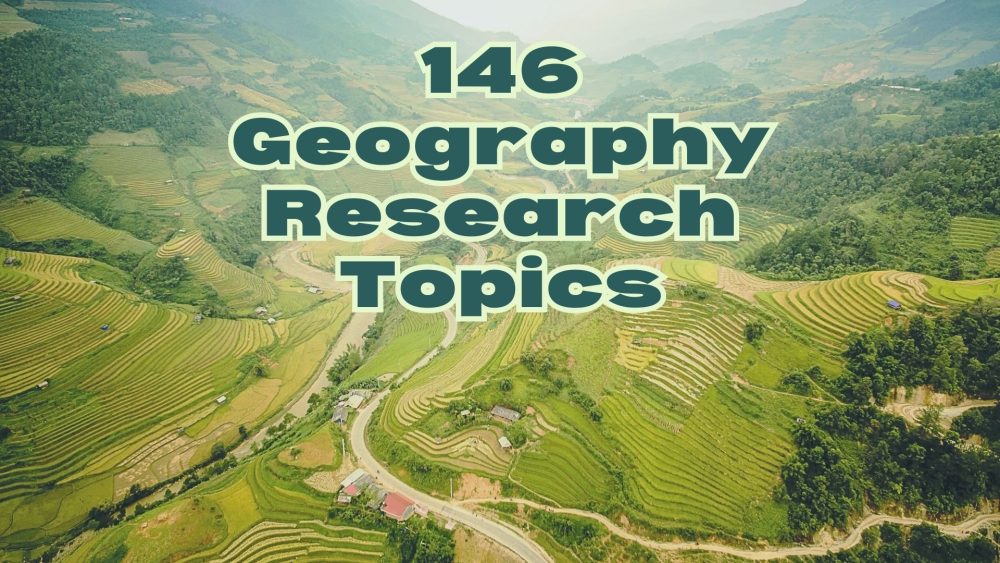
Are you a student seeking inspiration for your next geography research project? Look no further! In this article, we present you with a treasure trove of 146 original and top-quality geography research topics, completely free of charge. Whether you’re pursuing a degree in geography or simply passionate about exploring the world around you, these topics cover a wide range of fascinating subjects.
From human geography and cultural landscapes to physical geography and environmental sustainability, we’ve got you covered. Each topic is carefully crafted to ignite your curiosity and help you delve deeper into the field. Get ready to embark on an exciting journey of exploration and discovery as you uncover unique research ideas that will captivate both you and your readers.
Areas Of Geography
Geography is a field of study that explores the Earth’s physical features, human activities and their interactions. It examines the spatial patterns, processes, and relationships between the environment and society. Geographers investigate the Earth’s surface, analyzing its landscapes, climate, ecosystems and resources, as well as the distribution of populations, cultures, economies, and political systems. There are several types of geography, each focusing on specific aspects of the Earth’s physical and human dimensions:
Physical geography examines natural phenomena like landforms, weather and ecosystems. Human geography studies human activities, such as population distribution, urbanization and cultural landscapes. Economic geography explores the spatial patterns of economic activities, trade and resource distribution. Political geography analyzes the political systems, boundaries and geopolitical relationships between regions. Environmental geography investigates the interactions between humans and the environment, including environmental issues and sustainability. Geographical information systems (GIS) and remote sensing employ technology to analyze spatial data and maps.
These subfields together provide a comprehensive understanding of the Earth’s complexities and its relationship with human society.
Easy Geography Research Paper Topics
Want to write your paper in just a couple of hours? Explore a curated list of accessible and easy geography research paper topics that will make your geography research paper writing a breeze:
- The impact of climate change on coastal regions
- Exploring the relationship between geography and tourism
- Analyzing urbanization trends in developing countries
- Investigating the effects of deforestation on biodiversity
- Examining the role of geography in natural disaster management
- Studying the cultural landscape of a specific region
- Analyzing the geography of food production and distribution
- Exploring the impact of transportation on urban development
- Investigating the geography of renewable energy sources
- Analyzing the spatial patterns of population growth
- Studying the impact of globalization on local economies
- Examining the geography of water resources and management
Human Geography Research Topics
Improve your chances of getting a top grade! Delve into the complex interplay between humans and their environment with this comprehensive list of human geography research topics:
- Exploring the social implications of gentrification in urban areas
- Analyzing the influence of gender on migration patterns
- Investigating the impact of globalization on cultural identity
- Examining the geography of poverty and social inequality
- Studying the relationship between health and geographical location
- Analyzing the spatial distribution of ethnic communities in cities
- Investigating the geography of political power and governance
- Exploring the role of geography in shaping human behavior
- Analyzing the impacts of urban sprawl on communities
- Studying the geography of education access and quality
- Examining the spatial patterns of crime and its socio-economic factors
- Investigating the geography of healthcare provision and disparities
Cultural Geography Research Topics
Interested in cultural geography? Immerse yourself in the rich tapestry of cultures and their geographical influences with this captivating list of cultural geography research topics:
- Analyzing the cultural landscapes of indigenous communities
- Exploring the impact of globalization on cultural diversity
- Investigating the geography of language and its preservation
- Examining the influence of religion on cultural landscapes
- Studying the role of cultural heritage in tourism development
- Analyzing the geography of cultural festivals and events
- Investigating the spatial patterns of cultural diffusion
- Exploring the impact of migration on cultural identities
- Analyzing the geography of music and its regional variations
- Investigating the role of food culture in shaping identities
- Examining the spatial distribution of cultural institutions
- Studying the geography of art and its impact on communities
Physical Geography Research Topics
Do you want to write about physical geography? Investigate the natural processes and phenomena shaping our planet through this collection of compelling physical geography research topics:
- Analyzing the processes of coastal erosion and their impacts
- Investigating the formation and characteristics of river systems
- Examining the effects of climate change on glacial landscapes
- Analyzing the spatial patterns of soil erosion and conservation
- Investigating the biogeography of specific ecosystems
- Exploring the impacts of climate on vegetation patterns
- Analyzing the geography of water resources and hydrology
- Investigating the formation and classification of landforms
- Examining the spatial distribution of biodiversity hotspots
- Studying the interactions between humans and the natural environment
- Exploring the impacts of urbanization on natural landscapes
Geography Thesis Topics
Are you busy planning your thesis? Engage in an in-depth exploration of geographic concepts and theories with this thought-provoking list of geography thesis topics:
- Investigating the geographical aspects of sustainable development
- Analyzing the impacts of climate change on vulnerable communities
- Exploring the role of geography in disaster risk reduction
- Studying the geography of migration and refugee movements
- Examining the relationship between urban planning and social equity
- Analyzing the spatial patterns of energy consumption and renewable solutions
- Exploring the geographical dimensions of political conflicts and peacebuilding
- Investigating the role of geography in land use planning and conservation
- Examining the impacts of globalization on local economies
Urban Geography Thesis Topics
Are you interested in writing about urban geography? Analyze the complexities of urban landscapes and urbanization processes with this curated selection of urban geography thesis topics:
- Analyzing the effects of gentrification on urban neighborhoods
- Investigating the role of urban design in creating sustainable cities
- Examining the spatial patterns of urban sprawl and its consequences
- Studying the geography of social segregation in urban areas
- Analyzing the impacts of transportation systems on urban mobility
- Investigating the relationship between urbanization and public health
- Exploring the geography of informal settlements and slums
- Analyzing the impacts of urban green spaces on quality of life
- Investigating the geography of urban food systems and food security
- Examining the role of technology in shaping smart cities
- Studying the spatial distribution of cultural and recreational amenities in cities
PhD Research Topics In Geography
Expand the boundaries of geographical knowledge and contribute to the field with this diverse and stimulating list of PhD research topics in geography:
- Analyzing the geography of environmental justice in urban areas
- Investigating the impacts of climate change on indigenous communities
- Examining the role of geography in disaster risk governance
- Studying the spatial patterns of land use change in rapidly urbanizing regions
- Analyzing the impacts of transportation infrastructure on accessibility and equity
- Investigating the geographical dimensions of health inequalities
- Exploring the relationship between globalization and urbanization processes
- Analyzing the geography of political conflicts and territorial disputes
- Investigating the impacts of natural resource extraction on local communities
- Studying the spatial dynamics of international migration and its consequences
- Exploring the geography of innovation and knowledge economies in cities
Captivating Research Topics In Geography
Looking for some captivating research topics in geography? Ignite curiosity and scholarly interest with this awesome collection of research topics that delve into various aspects of geography:
- Investigating the geography of mega-cities and their challenges
- Analyzing the impacts of climate change on vulnerable coastal regions
- Exploring the spatial patterns of cultural landscapes and heritage sites
- Studying the geography of borderlands and transnational interactions
- Examining the impacts of tourism on local communities and environments
- The role of geography in understanding human-environment interactions
- Analyzing the spatial distribution of environmental pollution and its impacts
- Exploring the geography of global food systems and agricultural practices
- Investigating the impacts of natural disasters on urban resilience
- Examining the role of geography in understanding urban inequalities
- Studying the geography of geopolitical conflicts and their implications
- Exploring the impacts of technological advancements on landscapes
Interesting Geography Research Topics
Discover a wide range of interesting geography research topics that will pique your professor’s curiosity and offer new insights into the world of geography:
- Analyzing the impacts of climate change on glacier retreat and water resources
- Investigating the geography of renewable energy transition and its challenges
- Examining the spatial patterns of urban heat islands and their mitigation strategies
- Studying the impacts of land use change on biodiversity conservation
- Investigating the role of geography in understanding cultural diversity
- Exploring the geography of disease outbreaks and their spatial spread
- Investigating the impacts of natural hazards on human vulnerability and resilience
- Examining the spatial distribution of ecological corridors
- Studying the geography of regional economic disparities and development strategies
- Exploring the impacts of transportation infrastructure on urban accessibility
- The role of geography in understanding weather patterns
Good Geography Research Topics For 2023
Looking for some current topics to write about? Choose from a list of good geography research topics for 2023 that showcase the relevance and significance of geography in today’s world:
- Impacts of population growth on urban infrastructure and services in geography
- Geography of water scarcity and its implications for communities
- Spatial patterns of environmental conservation and protected areas in geography
- Impacts of land degradation on agricultural productivity and food security
- Geography of natural resource management and sustainable practices
- Relationship between climate change and human migration patterns in geography
- Spatial distribution of environmental justice and marginalized communities
- Impacts of urbanization on water pollution and ecosystem degradation
- Geography of renewable energy sources and their integration into the grid
- Role of geography in understanding regional conflicts over natural resources
- Impacts of deforestation on biodiversity loss and ecosystem services
Geography Topics For Research For College
Need some great geography topics for research for college? Explore a comprehensive list of geography research topics tailored for college-level studies, offering opportunities for critical analysis and exploration:
- Impacts of transportation infrastructure on urban air quality in geography
- Geography of urban gentrification and displacement
- Spatial patterns of urban food waste and its environmental consequences
- Impacts of tourism development on fragile ecosystems in geography
- Geography of environmental migration and its social implications
- Role of geography in understanding climate adaptation strategies
- Spatial distribution of environmental inequalities and environmental racism
- Impacts of land use change on water quality in agricultural regions
- Geography of geopolitical conflicts and territorial disputes
- Impacts of industrial pollution on urban health and well-being
- Role of geography in understanding disaster preparedness
Interesting Geography Topics For High School
Get the most interesting geography topics for high school. Foster geographical curiosity and critical thinking skills with this intriguing list of essay topics designed specifically by our best dissertation service writers for high school students:
- Analyzing the impacts of climate change on the polar regions
- Investigating the geography of natural hazards
- Examining the spatial distribution of endangered species
- Studying the impacts of urbanization on wildlife habitat fragmentation
- Exploring the geography of cultural diversity and multiculturalism in cities
- Investigating the role of geography in understanding climate variability
- Analyzing the spatial patterns of population distribution and density
- Investigating the geography of international migration and refugee flows
- Examining the impacts of tourism on local communities and cultures
- Studying the geography of natural resources
- Exploring the role of geography in understanding global inequality
Engaging Geographical Research Topics
Embark on a captivating journey of geographical exploration with this diverse collection of engaging geographical research topics, connecting people, places and the environment through insightful investigations:
- Urban sprawl impacts on land use and ecosystem services in geography
- Geography of renewable energy transition and its challenges
- Spatial patterns of urban heat islands and impacts on residents
- Impacts of climate change on coastal erosion and shoreline management
- Geography of water scarcity and implications for human populations
- Role of geography in understanding geopolitical conflicts and peacebuilding
- Spatial distribution of environmental pollutants and health effects
- Impacts of globalization on local economies and cultural landscapes
- Geography of gender inequalities and spatial dimensions
- Impacts of natural disasters on vulnerable communities and recovery
- Role of geography in understanding migration dynamics and urbanization
- Geography of political borders and their social and economic implications
Affordable Thesis Help You Can Rely On
When it comes to working on a geography research paper or a thesis for Master’s degree , our company is your trusted source for comprehensive writing help. Our team of expert writers consists of experienced professionals who specialize in geography, ensuring that you receive top marks for your school or class. We pride ourselves on delivering high quality and impressive custom written theses tailored to your specific requirements.
With our secure and fast online service, you can access thesis help that is not only affordable but available 24/7. Rest assured that your work will be handled by native English-speaking experts (ENL writers), guaranteeing exceptional quality and adherence to academic standards. Trust us for all your thesis needs and achieve academic success with ease.
Make sure to check our posts with other topics before you leave:
- 122 Best Ecology Topics To Sparkle Your Writing
- 195 Top Anthropology Topics For Great Thesis
- 170 Fantastic Astronomy Topics For High Scoring Tests
Why is choosing a great topic important when writing a geography essay?
Choosing a great topic ensures that your essay is engaging, relevant, and allows you to demonstrate your understanding of key geographical concepts while capturing the reader’s interest.
How can I choose a great topic for my geography essay?
To choose a great topic, consider current geographical issues, areas of personal interest and the availability of reliable sources. Additionally, ensure that the topic aligns with your essay’s objectives and requirements.
What are some strategies for narrowing down a geography essay topic?
To narrow down your topic, focus on specific geographical regions, phenomena, or concepts. Consider exploring the intersections between different aspects of geography, such as human and physical geography, to create a unique and well-rounded essay topic.
Can I get assistance in choosing a great topic for my geography essay?
Yes, you can seek guidance from your instructor, consult reputable academic resources or utilize online platforms that provide topic suggestions. Engaging in discussions with peers or experts in the field can also help generate ideas and refine your topic choice.

Leave a Reply Cancel reply
Your email address will not be published. Required fields are marked *
Comment * Error message
Name * Error message
Email * Error message
Save my name, email, and website in this browser for the next time I comment.
As Putin continues killing civilians, bombing kindergartens, and threatening WWIII, Ukraine fights for the world's peaceful future.
Ukraine Live Updates
Academia.edu no longer supports Internet Explorer.
To browse Academia.edu and the wider internet faster and more securely, please take a few seconds to upgrade your browser .
Enter the email address you signed up with and we'll email you a reset link.
- We're Hiring!
- Help Center

Recent Trends in Research in Urban Geography of India

Related Papers
Rishabh Misra
This paper aims at studying trends and patterns of urbanization in India. Paper has been divided into 2 parts, first pre-globalization period which was from 1951 to 1981; their position of urbanization and its trends have been analyzed. Second part deals with post-globalization period which is from 1991 to 2011, their urban status and pattern of urbanization in Indian economy has been analyzed. This was further divided under indicators like social, economic and infrastructure and housing, which give state-variation in urbanization pattern and revealed what is lacking if state has low urbanization rate. In the latter half of the paper urbanization policy “JNNURM” was analyzed and its role in developing urban infrastructure was studied with the help of project allocation and amounts sanctioned to state for urban renewal under this policy. Lastly suitable conclusion and recommendations have been provided in view of status of urbanization in India and problems it faces.
Ashis Sarkar
This paper focuses on the important aspect of the spatial dimension of urbanization in the most significant area which nevertheless bestows with vibrant spirit and soul, i.e. Kolkata Metropolitan Region in West Bengal, Eastern India. Attention initially has paid to the basic pattern of urbanization in West Bengal in broader aspect before turning to an analysis to justify the recent trend of the pattern of demographic changes which is measured by the population density with the help of Geographic Information System through ARC GIS (9.3 version) software that would help to widen the view point of the geographers to establish the fact of decentralization in the study area. To identify and assess the status of demographic surface the System Component Technique has been employed to show the changing nature of it. From the prepared map we have identified the future potential urban pockets which are besieged with reversal growth momentum in the peripheral areas of the core city of Kolkata in the last decade of 2001-2011. Keeping the above concept in the backdrop, it is essential to have an understanding the reason for developing the potential urban pockets for the sustainable management of the existing saturated and decaying urban system.
Piyush Sharma
Urban form is the study of human immigration and the process of their creation and revolution. The objective of the study is to figure out the economic structure and complexion of metropolitan cities of India by analyzing the arrangement pattern of its constituent parts and the progression of its development. Study begins with the analysis of substantial populace at diverse scales in addition to patterns of migration, property use, density, possession and livelihood in Indian cities. The study tries to explore the roots of divergence in urban form through assessment with socioeconomic growth indicators and ancient forms in many Indian cities. The study is expected to discover the various challenges in urban form and urbanization growth of Indian cities.
Sujata Patel
Anand Sahasranaman
Manoj Kumar Teotia
Urban development in North-Western Region of India comprising Punjab, Haryana, Himachal Pradesh, Jammu and Kashmir and Chandigarh is at cross roads. The Region is facing many crucial and new urban challenges in post liberalization era. The scale of emerging challenges, such as housing, slums, poverty, infrastructure and services, transportation, parking, environmental pollution, is unprecedented. Slums, with multiple deprivations, are growing rapidly even in the hilly states like Himachal Pradesh and Jammu and Kashmir due to migration of the poor population. Urban development seems to be neglected in urban policy planning over successive planning eras. The onset of liberal regimes in promoting development of real estate markets, beginning of low interest home loans, lack of strong regulation of sale and purchase of land and housing seem to have made them the commodity for speculation. Housing problem seem to acquire serious dimension in the wake of rapid urbanization, commodification of land and housing, distortion in land market and weakening of public sector housing provision. The social segregation and marginalization of urban poor continue to be major challenges. The town planning is poor and local governance is weak to cope with haphazard urbanization and emerging urban problems in the region. The deficiencies in infrastructure and services are visible and people’s perception about the same is very poor. The social and environmental fabric of cities in the region is under stress. Based on compilation of extensive data on various aspects of urban development in North-Western India, the book is an attempt to contribute to the existing debate on emerging trends, concerns and strategies in urban development in India. With the discussion on the city and state level case studies from the region, the volume tries to explore how state and city governments in North-Western India have been dealing with the emerging urban issues and challenges and what sort of local policies are emerging to deal with the growing crucial urban problems. The volume provides good source of relevant data/ information to planners, local and state level policy makers and students of urban studies.
Cybergeo : European Journal of Geography
Until now, studies of urbanization in India have been based only on official urban figures as provided by Census surveys. This approach has inevitably introduced several avoidable biases into the picture, distortions which are further compounded by numerous regional inter-Census adjustments. A much sounder option is now available in the Geopolis approach [www.e-geopolis.eu], which follows the United Nations system of classifying as urban all physical agglomerates with at least 10,000 inhabitants. From this standpoint, the Indian scenario exhibits all signs of a much-diffused process of urbanization rather than a major demographic polarization led by mega-cities. While 3,279 units were officially categorized as urban, the Geopolis criterion has identified 6,467 units with at least 10,000 inhabitants. Moreover, Geopolis estimates the urban population at 37% for 2001, which is 10% more than the official Census estimate. In absolute terms, this difference accounts for 100 million inhabitants. Brought to light by both physical identification and gradation of the census units of all localities as well as a study of the morphological profiles of individual agglomerates, a major finding reveals a greater spread of the country’s metro and secondary cities than previously believed. Statistical and political considerations have obscured the emergence of small agglomerations of between 10,000 and 20,000 inhabitants. This omission can only be seen as a gap in the national policy on planning and urban development. In other words, the country seems to be firmly headed toward an extended process of metropolitanization alongside diffused combinations of localized socio-economic opportunities, clusters, cottage industries, and market towns partially interlinked by developmental corridors. Far from a dual model of modern versus traditional, urban versus rural, metro city versus small town, the Indian subcontinent features many sub-regional settings which converge, overlap, and diverge. This study of the distribution of current and emerging agglomerations challenges the pertinence of the urban/rural divide.
Regional Statistics
India is one of the fastest growing and developing economies as well as societies of the world. An evident consequence of this trend is urbanisation, which poses an immense challenge for the population and political decision-makers of the country, and it is one of the most important social geographical topical research trends concerning India. First, this paper introduces the general urbanisation trends experienced in sovereign India in the 1951–2011 period, in the framework of an analysis of statistical data recorded in censuses, indicating the volume and trends of urbanisation. This step is followed by the demonstration of the structural features and diverse development paths of the million-plus agglomerations (i.e. agglomerations with at least a million inhabitants), connected to one of its main characteristics depicted by this introductory summary: metropolisation. This also allows the demonstration of the differences between the statistical and functional interpretation of metropolitan areas. Using the quantitative categories defined during the analysis, the authors classify the metropolises of India in terms of types of urbanisation through cluster analysis.
Suhani Gupta
The concept of urban and the phenomenon of urbanization are somewhat new to the human populations. In fact compared to the entire history of human evolution, it has only been fairly recently that people have begun to live in relatively dense urban agglomerations. Nonetheless, the speed at which societies have become urbanized is striking, and the extent to which the societies of today are urbanized and the size of present day agglomerates is unprecedented. Kingsley in his book notes that before 1850, no society could be described as being fundamentally urban in nature (kingsley, 1959). Today, all industrial nations, and many of the less developed countries, could be described as being urban societies. Moreover, the world is overall becoming more and more urban as time goes by as those living in less developed societies move toward the urban living patterns that have been common in some advanced societies for some time. Despite this rapid transformation of societies from primarily rural to primarily urban, and the importance of this evolution for the study of human population, the notion of urban remains fleeting, changing from time to time, differing across political boundaries, and being modified depending upon the purpose that the definition of the urban world serves. At times, the urban population are defined in terms of administrative boundaries, at times in terms of functional boundaries, and at times they are defines in terms of ecological factors such as density and population size. Although many of today’s social problems involves living in very large urban agglomerates, these divergences in defining the notion of urban has made It difficult to conduct comparative studies on urban population across time and across borders. In a sense, then, the difficulties encountered in defining urban create barriers to completely understand the phenomenon and finding solutions to a host of social problems that involve the urban population.
RELATED PAPERS
Maria Jimena Osorio Salazar
Journal of Raman Spectroscopy
robert bodnar
Augusta Bagiennorum. Storia e archeologia di una città augustea, a cura di M.C. Preacco, Torino
Giovanni Mennella
Cláudia Pecegueiro
Nature Communications
kevin o'shaughnessy
Neuropsychiatric Disease and Treatment
Marjie Hard
Diálogos sobre Inclusão
Jane Cleide Cordeiro
Matthew Naughton
muhammad hasyim
Gabriele Di Blasio
Journal of Clinical Microbiology
Applied Physics Letters
Fernanda Teixeira
Frontiers in Public Health
Anwar Suhaimi
Perfiles de Canarias
Teresa Rodríguez Hage
Hematology, Transfusion and Cell Therapy
Marina Conrado
Una Crowley
Companion of the 2023 ACM/IEEE International Conference on Human-Robot Interaction
Houda Elmimouni
The Smalltalk Report
OPUS International Journal of Society Researches
Alpaslan Gozler
International Journal of Applied Linguistics and English Literature
Leonardo Veliz
Karakter: Tijdschrift van Wetenschap
Raf Dekeyser
Régis de la Haye
Ion Exchange Technologies
Roman Rogoziński
Malvina Borgherini
- We're Hiring!
- Help Center
- Find new research papers in:
- Health Sciences
- Earth Sciences
- Cognitive Science
- Mathematics
- Computer Science
- Academia ©2024
- Society ›
- Geography & Nature
Environment of India - statistics & facts
Emerging climate-risks, environmental sustainability, key insights.
Detailed statistics
Urbanization in India 2022
Area of forest cover in India 2000-2021
Conservation areas India 2022, by type
Editor’s Picks Current statistics on this topic
Current statistics on this topic.
Natural Catastrophes
Number of heat wave days in India 2010-2022
Average monthly PM2.5 concentration in India 2020-2023, by select city
Related topics
Recommended.
- Environmental quality in China
- Natural disasters
- Environmental pollution worldwide
Recommended statistics
- Basic Statistic Global perception on impact of COP26 commitments on climate change 2022
- Basic Statistic Largest countries in the world by area
- Basic Statistic Land area in India 2021, by state and union territory
- Premium Statistic Global natural resource value leading countries 2021
- Premium Statistic Protected terrestrial area, by region 2000-2017
- Premium Statistic Protected marine area, by selected region 2000-2019
Global perception on impact of COP26 commitments on climate change 2022
Public perception on the impacts of COP26 commitments on climate change in selected countries worldwide in 2022
Largest countries in the world by area
The 30 largest countries in the world by total area (in square kilometers)
Land area in India 2021, by state and union territory
Geographical area of India in 2021, by state and union territory (in square kilometers)
Global natural resource value leading countries 2021
Leading countries worldwide based on natural resource value as of 2021 (in trillion U.S. dollars)
Protected terrestrial area, by region 2000-2017
Percentage of key biodiversity land* under protection worldwide in 2000, 2010 and 2017, by region
Protected marine area, by selected region 2000-2019
Percentage of key biodiversity marine areas under protection worldwide from 2000 to 2019, by region
- Premium Statistic Highest mountains in India by elevation 2023
- Premium Statistic Longest rivers in India 2023
- Premium Statistic Estimated length of coastline in India 2021, by state
- Premium Statistic Mangrove cover distribution in India 2021, by state
- Premium Statistic Number of natural inland wetlands across India FY 2018, by type
- Premium Statistic Area of forest cover in India 2000-2021
Highest mountains in India by elevation 2023
Highest mountains in India as of 2023, by elevation (in meters above sea level)
Longest rivers in India 2023
Longest rivers in India as of 2023 (in kilometers)
Estimated length of coastline in India 2021, by state
Estimated length of India's coastline in 2021, based on state (in kilometers)
Mangrove cover distribution in India 2021, by state
Mangrove cover distribution in India in 2021, by state
Number of natural inland wetlands across India FY 2018, by type
Number of natural inland wetlands located across India in financial year 2018, by type
Area of forest cover in India from 2000 to 2021 (in 1,000 square kilometers)
- Premium Statistic Average annual temperature in India 2001-2022
- Premium Statistic Annual rainfall volume in India 2012-2022
- Premium Statistic Monthly rainfall volume in India 2022
- Premium Statistic Annual rainfall in India 2022, by region
- Premium Statistic Number of heat wave days in India 2010-2022
- Premium Statistic Number of cold wave days in India 2010-2022
Average annual temperature in India 2001-2022
Average annual temperature in India from 2001 to 2022 (in degrees Celsius)
Annual rainfall volume in India 2012-2022
Annual rainfall in India from 2012 to 2022 (in millimeters)
Monthly rainfall volume in India 2022
Monthly rainfall in India in 2022 (in millimeters)
Annual rainfall in India 2022, by region
Annual rainfall in India in 2022, by region (in millimeters)
Average number of heat wave days in India from 2010 to 2022
Number of cold wave days in India 2010-2022
Average number of cold wave days in India from 2010 to 2022
Flora and fauna
- Premium Statistic Share of forest cover India 2021, by leading state
- Premium Statistic Number of wildlife sanctuaries in India 2023, by state
- Premium Statistic Number of national parks India 2023, by state
- Premium Statistic Estimated number of tigers in India 2006-2022
- Premium Statistic Number of known species of angiosperms India 2013-2019
- Premium Statistic Number of known species of gymnosperms India 2013-2019
- Premium Statistic Number of known species of fungi in India 2013-2019
Share of forest cover India 2021, by leading state
Share of forest cover as a percentage of geographical area in India in 2021, by leading state
Number of wildlife sanctuaries in India 2023, by state
Number of wildlife sanctuaries in India as of January 2023, by state
Number of national parks India 2023, by state
Number of national parks in India as of January 2023, by state
Estimated number of tigers in India 2006-2022
Estimated number of tigers in India from 2006 to 2022
Number of known species of angiosperms India 2013-2019
Number of known species of angiosperms in India from 2013 to 2019
Number of known species of gymnosperms India 2013-2019
Number of known species of gymnosperms in India from 2013 to 2019
Number of known species of fungi in India 2013-2019
Number of known species of fungi in India from 2013 to 2019
Opinion on climate change
- Premium Statistic Share of consumers trying to change their transport for climate change worldwide 2022
- Premium Statistic Share of consumers trying to replace flights for climate change worldwide 2022
- Premium Statistic Share of respondents likely to save water at home worldwide 2022
- Premium Statistic Consumers propensity to limit their contribution to climate change India 2022
- Premium Statistic Awareness of general population towards COP26 India 2022
Share of consumers trying to change their transport for climate change worldwide 2022
Share of consumers likely to walk, cycle, or use public transport instead of driving a car to limit their contribution to climate change in selected countries worldwide in 2022
Share of consumers trying to replace flights for climate change worldwide 2022
Share of consumers likely to stop flying, or replace some flights with trains or bus journeys to limit their contribution to climate change in selected countries worldwide in 2022
Share of respondents likely to save water at home worldwide 2022
Share of respondents who are likely to save water at their homes to limit their contribution to climate change in selected countries worldwide in 2022
Consumers propensity to limit their contribution to climate change India 2022
Propensity of consumers to limit their contribution to climate change in India as of March 2022
Awareness of general population towards COP26 India 2022
Awareness of general population towards COP26 in India as of March 2022
Further reports Get the best reports to understand your industry
Get the best reports to understand your industry.
Mon - Fri, 9am - 6pm (EST)
Mon - Fri, 9am - 5pm (SGT)
Mon - Fri, 10:00am - 6:00pm (JST)
Mon - Fri, 9:30am - 5pm (GMT)
100 Best universities for Geography and Cartography in India
Updated: February 29, 2024
- Art & Design
- Computer Science
- Engineering
- Environmental Science
- Liberal Arts & Social Sciences
- Mathematics
Below is a list of best universities in India ranked based on their research performance in Geography and Cartography. A graph of 5.72M citations received by 533K academic papers made by 473 universities in India was used to calculate publications' ratings, which then were adjusted for release dates and added to final scores.
We don't distinguish between undergraduate and graduate programs nor do we adjust for current majors offered. You can find information about granted degrees on a university page but always double-check with the university website.
1. Indian Institute of Science
For Geography and Cartography

2. Indian Institute of Technology Kharagpur

3. Indian Institute of Technology Delhi
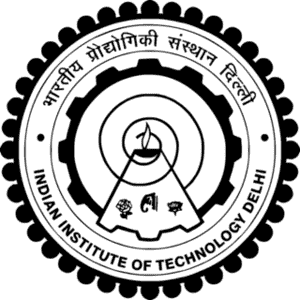
4. Indian Institute of Technology Madras

5. Indian Institute of Technology Bombay

6. Indian Institute of Technology Roorkee

7. Indian Institute of Technology Kanpur

8. Banaras Hindu University
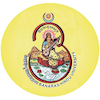
9. University of Delhi

10. VIT University

11. Jadavpur University

12. Jawaharlal Nehru University

13. Anna University

14. Indian Institute of Technology Guwahati

15. All India Institute of Medical Sciences Delhi
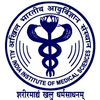
16. Indian School of Mines

17. Indian Agricultural Research Institute
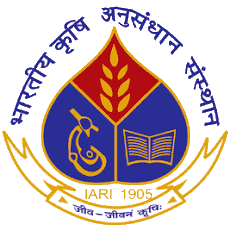
18. Aligarh Muslim University

19. University of Calcutta

20. Indian Statistical Institute
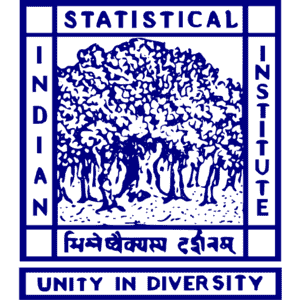
21. Amrita University
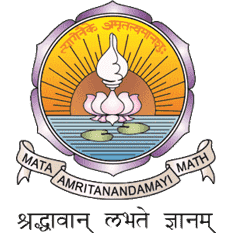
22. National Institute of Technology, Rourkela

23. National Institute of Technology, Tiruchirappalli

24. Thapar Institute of Engineering and Technology

25. Manipal Academy of Higher Education

26. Sardar Vallabhbhai National Institute of Technology, Surat
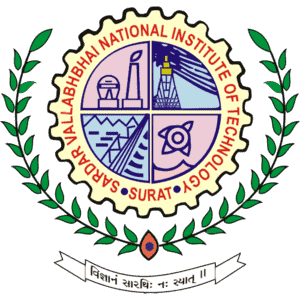
27. Savitribai Phule Pune University

28. Punjab Agricultural University


29. University of Hyderabad

30. National Islamic University

31. National Institute of Technology, Karnataka

32. Amity University

33. Panjab University

34. National Institute of Technology, Warangal

35. Tata Institute of Fundamental Research

36. Post Graduate Institute of Medical Education and Research

37. Birla Institute of Technology and Science

38. Pondicherry University

39. Institute of Chemical Technology

40. SRM Institute of Science and Technology

41. Malaviya National Institute of Technology, Jaipur

42. Maulana Azad National Institute of Technology

43. Christ University

44. Sri Venkateswara University

45. University of Mumbai
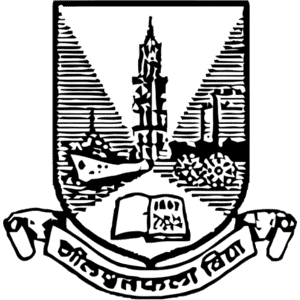
46. Indian Institute of Engineering Science and Technology, Shibpur

47. Andhra University

48. Indian Institute of Technology, BHU

49. National Institute of Technology, Kurukshetra

50. Annamalai University
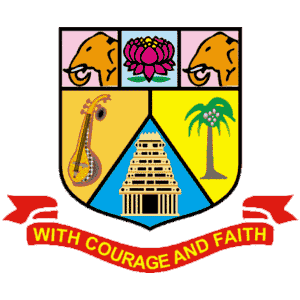
51. National Institute of Technology, Silchar

52. University of Burdwan
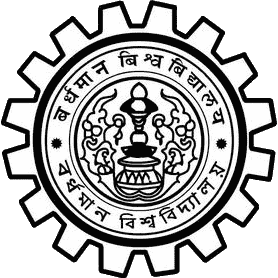
53. Indian Institute of Technology Hyderabad

54. Cochin University of Science and Technology

55. National Institute of Technology, Hamirpur

56. Visvesvaraya National Institute of Technology
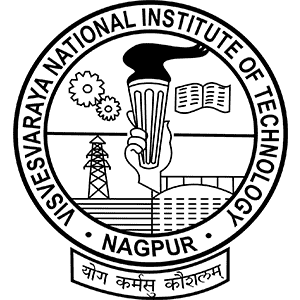
57. Delhi Technological University

58. Guru Nanak Dev University

59. Motilal Nehru National Institute of Technology Allahabad
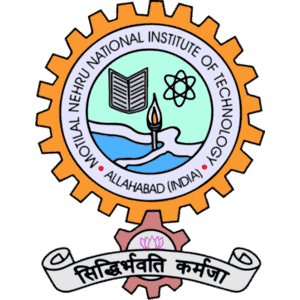
60. Indian Institute of Technology Bhubaneswar

61. Lovely Professional University

62. University of Allahabad

63. Tamil Nadu Agricultural University
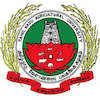
64. Indian Institute of Technology Indore

65. Bangalore University
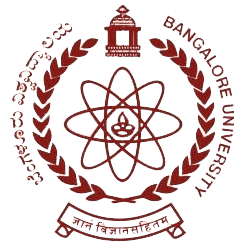
66. Bharathiar University

67. Osmania University

68. Chaudhary Charan Singh Haryana Agricultural University

69. KIIT University

70. National Institute of Technology, Calicut

71. National Institute of Technology, Durgapur

72. Visva-Bharati University

73. University of Kashmir

74. Siksha O Anusandhan University

75. Govind Ballabh Pant University of Agriculture and Technology

76. Birla Institute of Technology

77. Sathyabama Institute of Science and Technology

78. Jawaharlal Nehru Centre for Advanced Scientific Research

79. SASTRA University

80. Dr. B R Ambedkar National Institute of Technology Jalandhar

81. University of Kalyani

82. Jawaharlal Nehru Technological University

83. Kurukshetra University

84. Gulbarga University
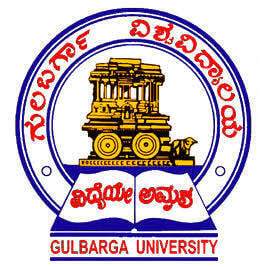
85. Tezpur University

86. Devi Ahilya University / Indore University

87. K L University

88. Presidency University - Kolkata

89. Indian Institute of Technology Gandhinagar

90. Karunya Institute of Technology and Sciences

91. University of Petroleum and Energy Studies

92. University of Kerala
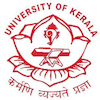
93. Shivaji University

94. University of Madras

95. University of Rajasthan

96. Vidyasagar University

97. Punjabi University Patiala
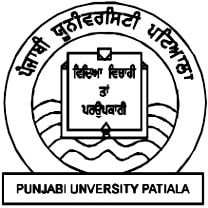
98. Mangalore University

99. Kuvempu University

100. North Eastern Hill University

The best cities to study Geography and Cartography in India based on the number of universities and their ranks are Bangalore , Kharagpur , Delhi , and Chennai .
Environmental Science subfields in India
Population and geography in India
- PMID: 12179043
PIP: The field of population geography was first introduced during the 1960s in India and advanced under the direction of Gosal at the Punjab University. Teaching and research in population geography were introduced by Chandigarh at Punjab University, which today is the main center of research activity. Population geography in India has followed the main tenets of geography in general and is based on spatial perspectives. Deficits are apparent in the paucity of research on socioeconomic implications of spatial distributions, but there is infrastructural feedback to support theory development. Theoretical advances moving from theory to fact or from empirical fact to theory are limited. Comprehensive training in methodology and quantitative techniques is needed for further development of population theory: multivariate analysis, factor analysis, principal component analysis, model building, hypothesis testing, and theory formulation. Methodological sophistication will also help in understanding and interpreting the diverse and complex Indian demographic situation. The analysis of population geography in the Indian spatial, cultural, political, and historical context may be applied to other less developed countries of similar sociocultural background. The Indian Census has contributed over the 100 years of its existence reliable and efficiently produced data on a wide variety of measures at assorted scales down to the village level. Field work among geographers has not achieved a level of development commensurate with population censuses. Recent doctoral research has focused on qualitative studies of local situations. Research topics range from the distribution and structure of population, mortality, fertility, and migration to peripheral issues of social segregation. Popular topics include urbanization, labor force, sex composition, literacy, and population growth. Distribution of population and density studies have amounted to only 2 in 30 years. Population texts are in abundance. The Punjab University is the headquarters of the Association of Population Geographers, which publishes the journal "Population Geography." Many advances are still needed in a timely fashion.
- Demography*
- Developing Countries
- Evaluation Studies as Topic*
- Population*
- Social Sciences
Let Us Help you!

Forgot Password
Don't have an account register.
TOP 50 MOST IMPORTANT TOPICS FOR GEOGRAPHY BY JV's IAS ACADEMY
Updated on 3 October, 2020
Target 2021 Preparation Strategy
--> --> --> --> --> --> --> -->.
.png)
TOP 50 IMPORTANT TOPICS OF GEOGRAPHY FOR UPSC (PRELIMS + MAINS) 1. Let us start with number of questions being asked from geography every year in UPSC prelims . YEAR NUMBER OF QUESTIONS ASKED 2011 11 2012 12 2013 09 2014 12 2015 14 2016 07 2017 07 2018 08 2019 14 From this trend we can see that the marks vary from 15-30 marks every year i.e. 15 % of the total marks i.e. 200 marks. Now we will see about the top 50 topics of Geography and why. TOP 50 GEOGRAPHY TOPICS TOPIC NAME WHY IT IS IMPORTANT? Origin and evolution of the earth UPSC PRELIMS 2017 : The terms ‘Event Horizon’, ‘Singularity’, `String Theory’ and ‘Standard Model’ are sometimes seen in the news in the context of (a) Observation and understanding of the Universe (b) Study of the solar and the lunar eclipses (c) Placing satellites in the orbit of the Earth (d) Origin and evolution of living organisms on the Earth UPSC 2012: Earthquake Recent Delhi and other earthquakes Volcanoes Upsc prelims 2018: Continental drift theory Recently Zealandia continent found which marks the correctness of the drift theory UPSC 2014: Plate tectonics Mountain building process : HIMALAYAN FORMATION. Types of Landforms UPSC 2012: Soil formation UPSC 2010: Solar radiation & Heat budget of the earth Global warming Upsc questions 2013: Atmospheric circulation – cyclones, westerlies, jet streams Recent amphan cyclone UPSC 2015: UPSC 2015: Evaporation, condensation and precipitation Thunderstorm and lightning in Bihar and up UPSC 2019: UPSC 2013: World climate and climate change UPSC 2015: Relief of the oceans Temperature and salinity distribution in the ocean. UPSC 2012: Types of ocean current UPSC 2015: Ecosystem UPSC 2011: Biodiversity and conservation Upsc 2013: UPSC 2011: Physiography of India – mountains, hills, plateau, plains etc. UPSC 2017: UPSC 2015: Drainage system of India UPSC 2017: UPSC 2016: Climate of India – Indian monsoon UPSC 2014: Natural vegetation and soils of India – National parks, biosphere reserves, mangroves etc. UPSC 2016: UPSC 2015: Upsc questions: 2018 UPSC 2011: Natural disasters- Floods, droughts, landslide,cyclones,earthquakes Tsunami. UPSC 2011: (TSUNAMI & MANGROVES) Indian agriculture and types UPSC 2019 – Coral reefs UPSC 2018: Consider the following statements : Most of the world’s coral reefs are in tropical waters. More than one-third of the world’s coral reefs are located in the territories of Australia, Indonesia and Philippines. Coral reefs host far more number of animal phyla than those hosted by tropical rainforests. Which of the statements given above is/are correct ? 1 and 2 only 3 only 1 and 3 only 1, 2 and 3 The above table consists of core geographical concepts, however there are some related geographical concepts also which we regularly see in current affairs: TOPIC NAME WHY IT IS IMPORTANT? 24.El- nino UPSC 2010: 25.La-nina UPSC 2011: Indian ocean dipole UPSC 2017: With reference to ‘Indian Ocean Dipole (IOD)’ sometimes mentioned in the news while forecasting Indian monsoon, which of the following statements is/are correct? 1. IOD phenomenon is characterised by a difference in sea surface temperature between tropical Western Indian Ocean and tropical Eastern Pacific Ocean. 2. An IOD phenomenon can influence an El Nino’s impact on the monsoon. Select the correct answer using the code given below: (a) 1 only (b) 2 only (c) Both 1 and 2 (d) Neither 1 nor 2 Madden Julian oscillations CURRENT AFFAIRS : As good for Indian monsoon Polar vortex CURRENT AFFAIRS: ozone depletion & ozone hole Pacific decadal oscillations CURRENT AFFAIRS : Affect Indian monsoon Heat waves CRRENT AFFAIRS: criteria and European heat waves Sun spot cycles CURRENT AFFAIRS: effects climate change Forest fire CURRENT AFFAIRS: amazon fire , Australian bush fire Tribes of the world and India UPSC 2019 Heat islands INCREASING AIR POLLUTION IN METRO CITIES Seismic noise CURRENT AFFAIRS Environmental impact assessment NEW EIA DRAFT BILL 2020 Ring of fire Volcanic eruptions in pacific ocean : Indonesian and Philippines volcanic eruption. Wetlands and their conservation UPSC 2012: Distribution of wildlife and their conservation Upsc 2013: Places in news Upsc 2018 UPSC 2018 Mountain passes and lakes (part of physiography of India) UPSC 2018 Major straits of the world UPSC 2011: Major water bodies – Mediterranean sea, Caspian sea, black sea etc. (part of oceanography) UPSC 2019: Population and related issues Labour migration, sex ratio and relates schemes UPSC 2011: Minerals and their distribution Upsc 2018 International trade CURRENT AFFAIRS :Trade deficit of India with china Energy resources and crisis UPSC 2013: Industrial setup Sez, nimz (National Investment Manufacturing Zone) , sagarmala UPSC 2015: (CAN ALSO BE INCLUDED UNDER MINERALS TOPIC) Transport and communication Air India nationalisation (upsc pre),AGR (Adjusted gross revenue of telecom company) UPSC 2016: Water conservation UPSC 2014: Some topics may seems to overlap with Environment and ecology and also with economics and current schemes but it forms and essential part of Geography. The human geography deals with population and related issues like migration etc is to be covered. Also there are different government schemes also for solving the population related issues like beti bachao beti padhao abhiyan etc. This shows that how geography is related to other subjects like economy, society and even history. Therefore if you prepare geography very thoroughly it will also help you in the completion of other subjects also. Some Important Links: UPSC Prelims 2019 Question Paper pdf Article 300A Instruments of Capital Market Capital Market Instruments Parliamentary form of Government in India Explain the Current Trends in Inflation Classification of Environment First Past the Post System UPSC Environmental Clearance Process in India How to Read Spectrum Modern History

Editorial: Politics of Diplomacy- India-Maldives relations: Don’t overreact
.jpg)
Editorial: Attacks on interfaith couples: The moral police again

Editorial: To combat climate change, citizens and government must join hands

Editorial: Mumbai Trans Harbour Link: Bridge to prosperity

You are not logged in. For bookmarking this please login first.
Read our research on: Gun Policy | International Conflict | Election 2024
Regions & Countries
3. problems students are facing at public k-12 schools.
We asked teachers about how students are doing at their school. Overall, many teachers hold negative views about students’ academic performance and behavior.
- 48% say the academic performance of most students at their school is fair or poor; a third say it’s good and only 17% say it’s excellent or very good.
- 49% say students’ behavior at their school is fair or poor; 35% say it’s good and 13% rate it as excellent or very good.
Teachers in elementary, middle and high schools give similar answers when asked about students’ academic performance. But when it comes to students’ behavior, elementary and middle school teachers are more likely than high school teachers to say it’s fair or poor (51% and 54%, respectively, vs. 43%).
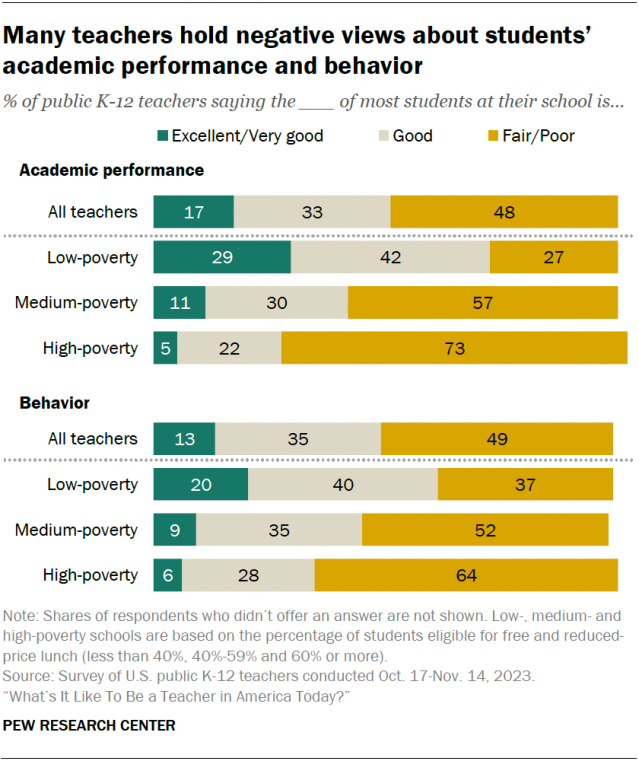
Teachers from high-poverty schools are more likely than those in medium- and low-poverty schools to say the academic performance and behavior of most students at their school are fair or poor.
The differences between high- and low-poverty schools are particularly striking. Most teachers from high-poverty schools say the academic performance (73%) and behavior (64%) of most students at their school are fair or poor. Much smaller shares of teachers from low-poverty schools say the same (27% for academic performance and 37% for behavior).
In turn, teachers from low-poverty schools are far more likely than those from high-poverty schools to say the academic performance and behavior of most students at their school are excellent or very good.
Lasting impact of the COVID-19 pandemic
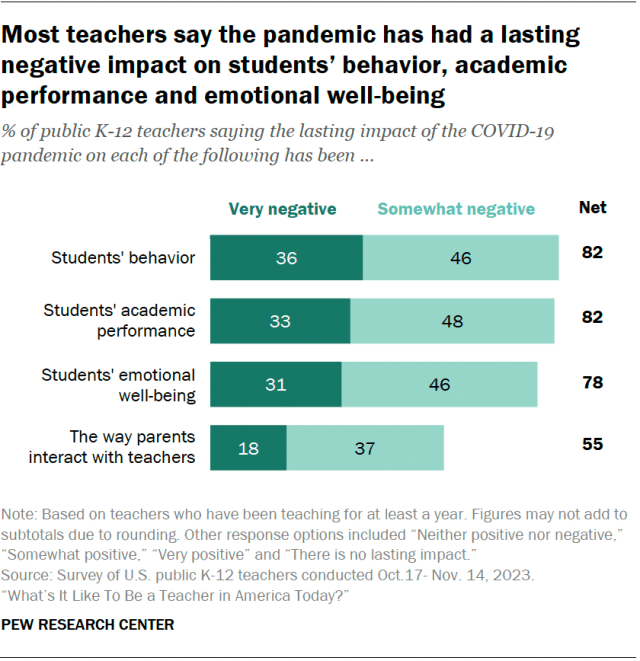
Among those who have been teaching for at least a year, about eight-in-ten teachers say the lasting impact of the pandemic on students’ behavior, academic performance and emotional well-being has been very or somewhat negative. This includes about a third or more saying that the lasting impact has been very negative in each area.
Shares ranging from 11% to 15% of teachers say the pandemic has had no lasting impact on these aspects of students’ lives, or that the impact has been neither positive nor negative. Only about 5% say that the pandemic has had a positive lasting impact on these things.
A smaller majority of teachers (55%) say the pandemic has had a negative impact on the way parents interact with teachers, with 18% saying its lasting impact has been very negative.
These results are mostly consistent across teachers of different grade levels and school poverty levels.
Major problems at school
When we asked teachers about a range of problems that may affect students who attend their school, the following issues top the list:
- Poverty (53% say this is a major problem at their school)
- Chronic absenteeism – that is, students missing a substantial number of school days (49%)
- Anxiety and depression (48%)
One-in-five say bullying is a major problem among students at their school. Smaller shares of teachers point to drug use (14%), school fights (12%), alcohol use (4%) and gangs (3%).
Differences by school level
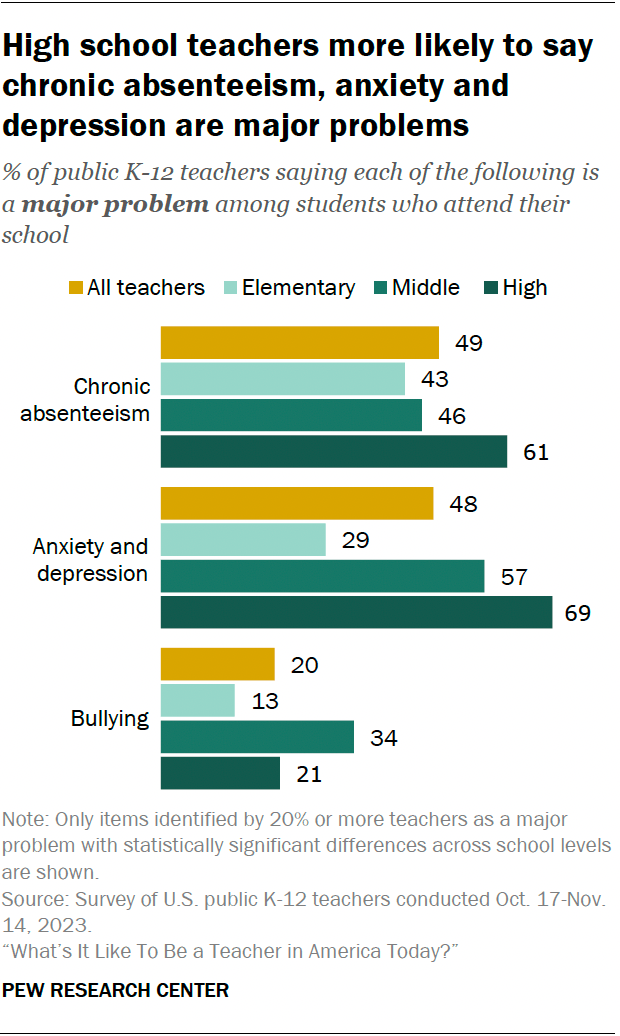
Similar shares of teachers across grade levels say poverty is a major problem at their school, but other problems are more common in middle or high schools:
- 61% of high school teachers say chronic absenteeism is a major problem at their school, compared with 43% of elementary school teachers and 46% of middle school teachers.
- 69% of high school teachers and 57% of middle school teachers say anxiety and depression are a major problem, compared with 29% of elementary school teachers.
- 34% of middle school teachers say bullying is a major problem, compared with 13% of elementary school teachers and 21% of high school teachers.
Not surprisingly, drug use, school fights, alcohol use and gangs are more likely to be viewed as major problems by secondary school teachers than by those teaching in elementary schools.
Differences by poverty level
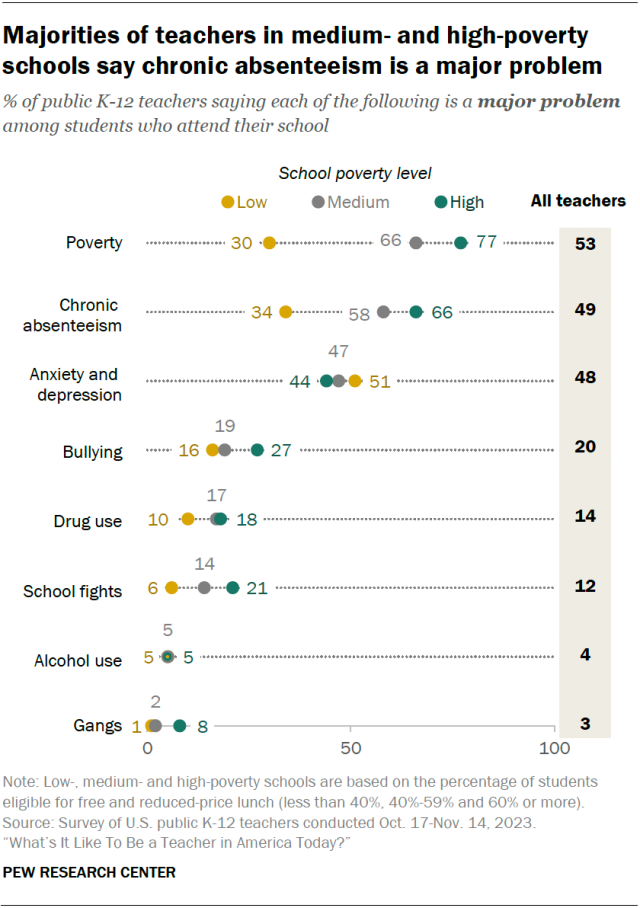
Teachers’ views on problems students face at their school also vary by school poverty level.
Majorities of teachers in high- and medium-poverty schools say chronic absenteeism is a major problem where they teach (66% and 58%, respectively). A much smaller share of teachers in low-poverty schools say this (34%).
Bullying, school fights and gangs are viewed as major problems by larger shares of teachers in high-poverty schools than in medium- and low-poverty schools.
When it comes to anxiety and depression, a slightly larger share of teachers in low-poverty schools (51%) than in high-poverty schools (44%) say these are a major problem among students where they teach.
Discipline practices
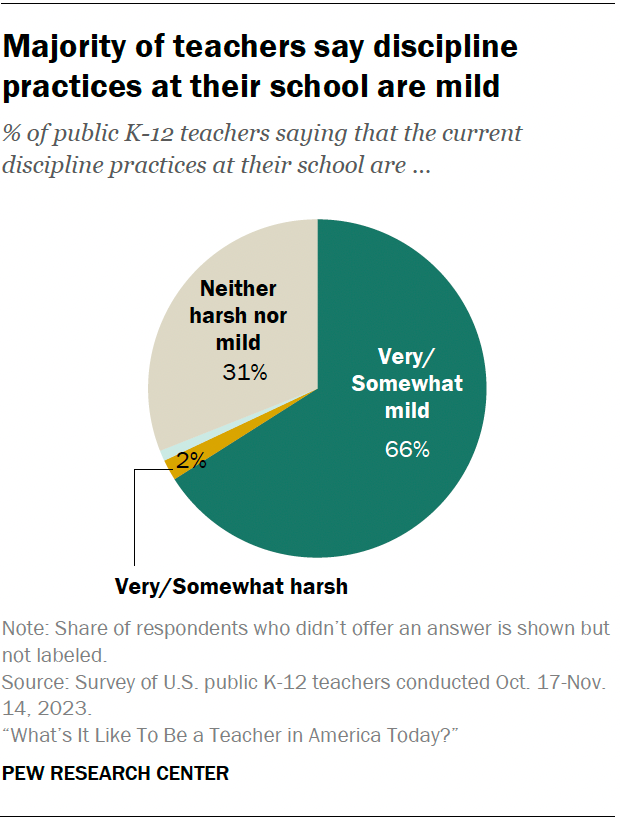
About two-thirds of teachers (66%) say that the current discipline practices at their school are very or somewhat mild – including 27% who say they’re very mild. Only 2% say the discipline practices at their school are very or somewhat harsh, while 31% say they are neither harsh nor mild.
We also asked teachers about the amount of influence different groups have when it comes to determining discipline practices at their school.
- 67% say teachers themselves don’t have enough influence. Very few (2%) say teachers have too much influence, and 29% say their influence is about right.
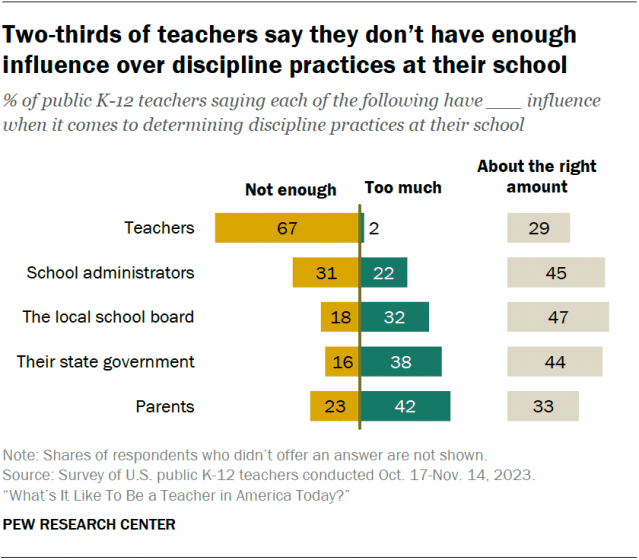
- 31% of teachers say school administrators don’t have enough influence, 22% say they have too much, and 45% say their influence is about right.
- On balance, teachers are more likely to say parents, their state government and the local school board have too much influence rather than not enough influence in determining discipline practices at their school. Still, substantial shares say these groups have about the right amount of influence.
Teachers from low- and medium-poverty schools (46% each) are more likely than those in high-poverty schools (36%) to say parents have too much influence over discipline practices.
In turn, teachers from high-poverty schools (34%) are more likely than those from low- and medium-poverty schools (17% and 18%, respectively) to say that parents don’t have enough influence.
Social Trends Monthly Newsletter
Sign up to to receive a monthly digest of the Center's latest research on the attitudes and behaviors of Americans in key realms of daily life
Report Materials
Table of contents, ‘back to school’ means anytime from late july to after labor day, depending on where in the u.s. you live, among many u.s. children, reading for fun has become less common, federal data shows, most european students learn english in school, for u.s. teens today, summer means more schooling and less leisure time than in the past, about one-in-six u.s. teachers work second jobs – and not just in the summer, most popular.
About Pew Research Center Pew Research Center is a nonpartisan fact tank that informs the public about the issues, attitudes and trends shaping the world. It conducts public opinion polling, demographic research, media content analysis and other empirical social science research. Pew Research Center does not take policy positions. It is a subsidiary of The Pew Charitable Trusts .

IMAGES
VIDEO
COMMENTS
Regional Geography Research Topics. Socioeconomic disparities between urban and rural regions in India. Geopolitical tensions in the South China Sea. Cultural diversity and integration in multicultural cities like London or New York. Environmental challenges facing the African Sahel region.
Here are some of the best human geography research topics to consider for your papers. India and China - The universal effects of the increasing economic powers of these countries. Ethnic Dressing evolution through different centuries. Human culture - How it has changed over time.
Crime in India is arguably an under-researched subject. Studies that explore the theme as a sociological phenomenon do so through the lens of gender [30,33] and caste . The caste system in India today emerges from the ancient 'varna' system, where society was divided into five hereditary, endogamous, and occupation-specific groups .
Urban Studies as a distinctive scholarly field took shape in India around the turn of the 21st century (Appadurai, 2000; Prakash, 2002; see Sood, 2020, for a survey).Earlier work largely comprised policy-facing studies by economists, planners, sociologists and demographers who commented on the steep waves of urbanisation that overtook Indian cities in the 1960s and 70s, highlighting problems ...
The current study aims to provide an overview of the research carried out in India on geoheritage in the last 12 years (2010--022). The research on the topic of interest is retrieved from the Scopus, Science Direct, and Google Scholar databases. ... Department of Geography, Swami Shraddhanand College, University of Delhi, Alipur, Delhi ...
Abstract. Geography in India has come a long way since the establishment of first under-graduate department in 1924 and post-graduate department in 1926. It has expanded both spatially and ...
By the time of Platinum Jubilee of the Society in 2008 more than 2,000 research papers have been brought out in the journal. All these articles published in the journal covered as many as 50 topics of geography. The Geographical Review of India is brought out quarterly in the months of March, June, September and December.
Abstract. This paper examines the present status of geography in India and problems based on trends in modern history, geography education and research. Geography has developed remarkably in higher education since the country won independence from Great Britain. Large numbers of universities and colleges have been established since the 1960s ...
The study of geography as a systematic science was a significant gap in Indian knowledge during ancient times. However, geographical facts were presented in a nonsystematic manner in the whole range of Sanskrit, Pali, and Prakrit literature. Compositions of a geographical character are often found embedded in the religious, legendary and ...
Researching Geography. : Gopal Krishan, Nina Singh. Taylor & Francis, Aug 21, 2019 - Social Science - 268 pages. This book is a one-stop comprehensive guide to geographical inquiry. The volume: traces the step-by-step account of the whys and the hows of research methodology; introduces complexities of the geographical perspective, selection of ...
Examining the role of geography in natural disaster management. Studying the cultural landscape of a specific region. Analyzing the geography of food production and distribution. Exploring the impact of transportation on urban development. Investigating the geography of renewable energy sources.
Related Papers. This paper aims at studying trends and patterns of urbanization in India. Paper has been divided into 2 parts, first pre-globalization period which was from 1951 to 1981; their position of urbanization and its trends have been analyzed. Second part deals with post-globalization period which is from 1991 to 2011, their urban ...
It is the study of topics relating to geology, meteorology, and hydrology that makes one-third of the departments of geography in India confer a degree in science. Another reason to ignore geography. among the social sciences could be that its field of study includes. the physical realm: land, water, soil, vegetation.
Received Date: 28 /01/2020 Acceptance Date: 09 /02/2020 Publication Date: 29/02/2020. Available online on - WWW.IJIRMF.CO M Page 15. North East India: An Underdeveloped Region w ith Unbound ...
roadmap to improve India's geography education in response to the demand of growing economic liberalization and rapidly changing Indian societies. These papers are essential readings for both students and teachers of geography in India. The volume offers sustainable educational capabilities to various cross-sections of Indian Geography."
Sarfaraz Alam. This article critically examines the recommendations of two major Indian education reports—NCFSE 2000 and NCF 2005—prepared by the National Council of Educational Research and Training in India. The NCFSE 2000 has recommended an integrated teaching of geography as one component of the social studies.
Geography in India has come a long way since the establishment of first under-graduate department in 1924 and post-graduate department in 1926. It has expanded both spatially and vertically.
Find the latest statistics and facts related to the environment and geography of India. ... Customized Research & Analysis projects: ... a compact summary of the topic of "Environment of India ...
Below is the list of 100 best universities for Geography and Cartography in India ranked based on their research performance: a graph of 5.72M citations received by 533K academic papers made by these universities was used to calculate ratings and create the top. ... papers database with 98,302,198 scientific publications and 2,149,512,106 ...
Population geography in India has followed the main tenets of geography in general and is based on spatial perspectives. Deficits are apparent in the paucity of research on socioeconomic implications of spatial distributions, but there is infrastructural feedback to support theory development. Theoretical advances moving from theory to fact or ...
In today's world, geography education is experiencing revival and rejuvenation thanks to new technologies, research-based learning, problem solving based education, teaching programs and ...
Transport and communication. Air India nationalisation (upsc pre),AGR (Adjusted gross revenue of telecom company) UPSC 2016: Water conservation. UPSC 2014: Some topics may seems to overlap with Environment and ecology and also with economics and current schemes but it forms and essential part of Geography.
THE RESEARCH TASK A HYPOTHESIS TESTING APPROACH TO RESEARCH TASKS IN GEOGRAPHY FET Table 1: Research Activity and Due Date Steps Marks Descriptor(s) Term Formulation of the hypothesis Due Date: 1 10 Hypothesis (Must be in the form of a statement including - what, where and impact of geographical issue) Term 1 & 2 2024 Geographical Mapping ...
Major problems at school. When we asked teachers about a range of problems that may affect students who attend their school, the following issues top the list: Poverty (53% say this is a major problem at their school) Chronic absenteeism - that is, students missing a substantial number of school days (49%) Anxiety and depression (48%) One-in ...
Abstract. Geography is an inter-disciplinary subject. It is an essential academic field, which is needed for all walks of human life and a nation's development. By definition, Geography is the ...